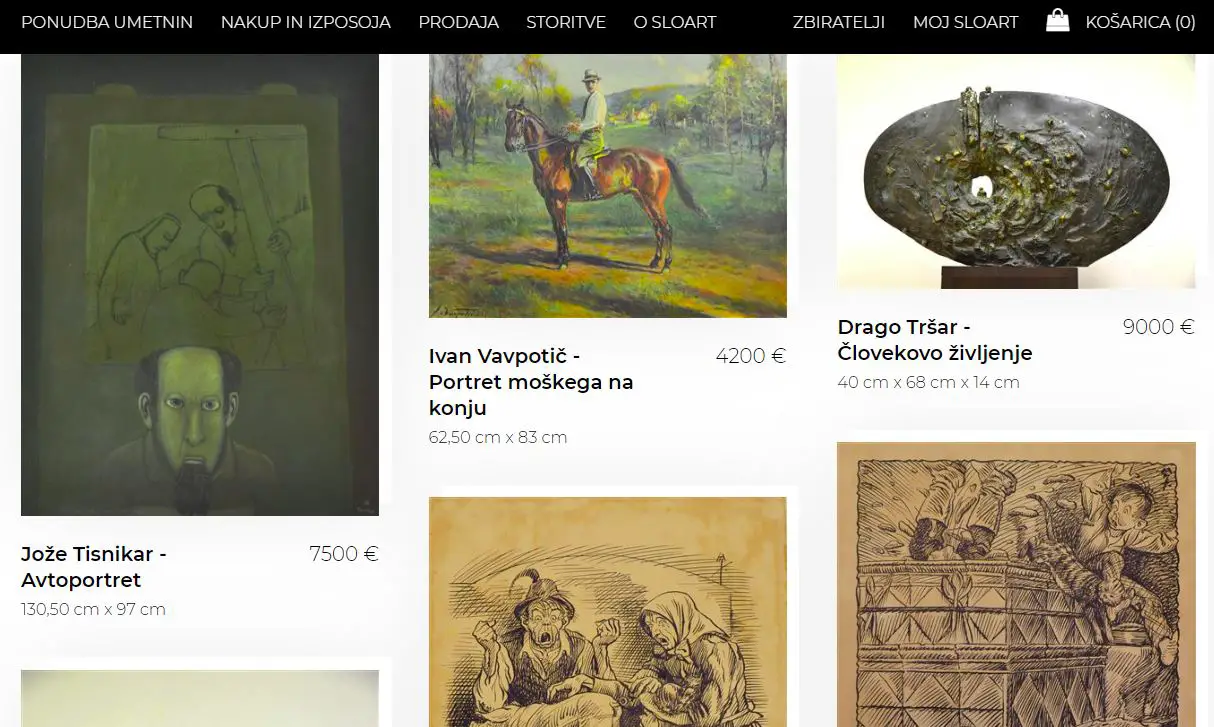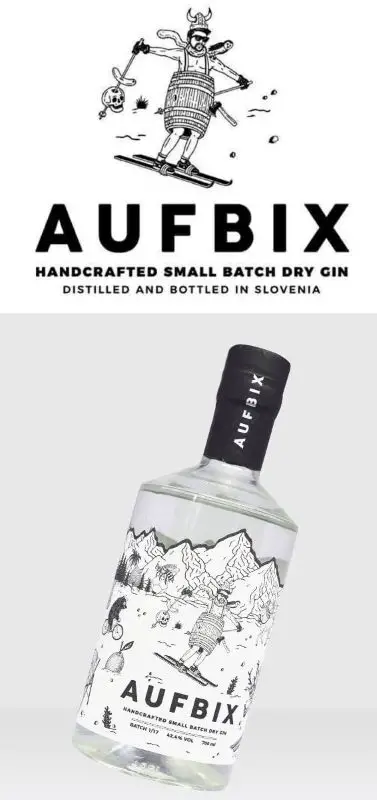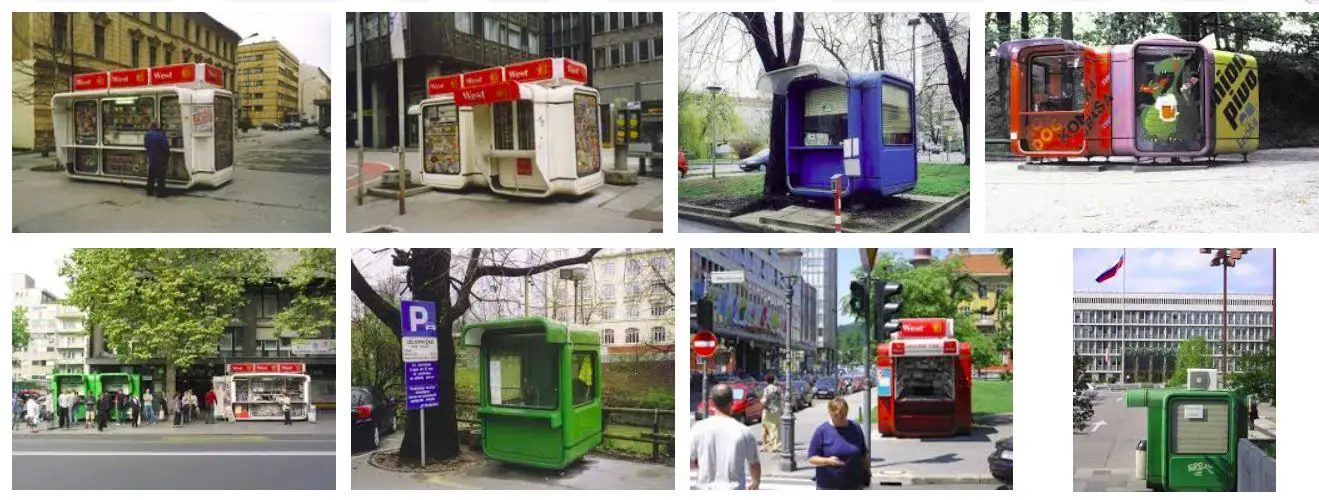Made in Slovenia
July 7, 2019
You might not have heard of the Trans-Universal Zombie Church of Blissful Ringing yet, but this growing religion is currently the fifth biggest belief system in Slovenia.
The church was formed in 2013 in close relation to the 2012-13 anti-government protests. Originally the Church of Blissful Ringing added “zombie” to its name after the then ruling SDS of Janez Janša labelled the protesters as zombies in its Tweets.
In 2014 this indigenous Slovenian church was registered with the Office for Religious Communities of the Ministry of Culture under the number of order 46.
It currently has around 12,000 members, which makes it the fifth most popular religion in Slovenia, after the Roman Catholic Church, Islam, Christian Orthodox and Lutheran Church. It’s worth mentioning, however, that the current numbers of the other four religions date from the year 2002. After that the Government Statistics Office switched to a much cheaper register-based census (2011), which no longer provides data on citizens’ religious affiliation or ethnicity.
Since its inception the Church mostly operates democratically via its Facebook page. Its holy book was published in October 2014.
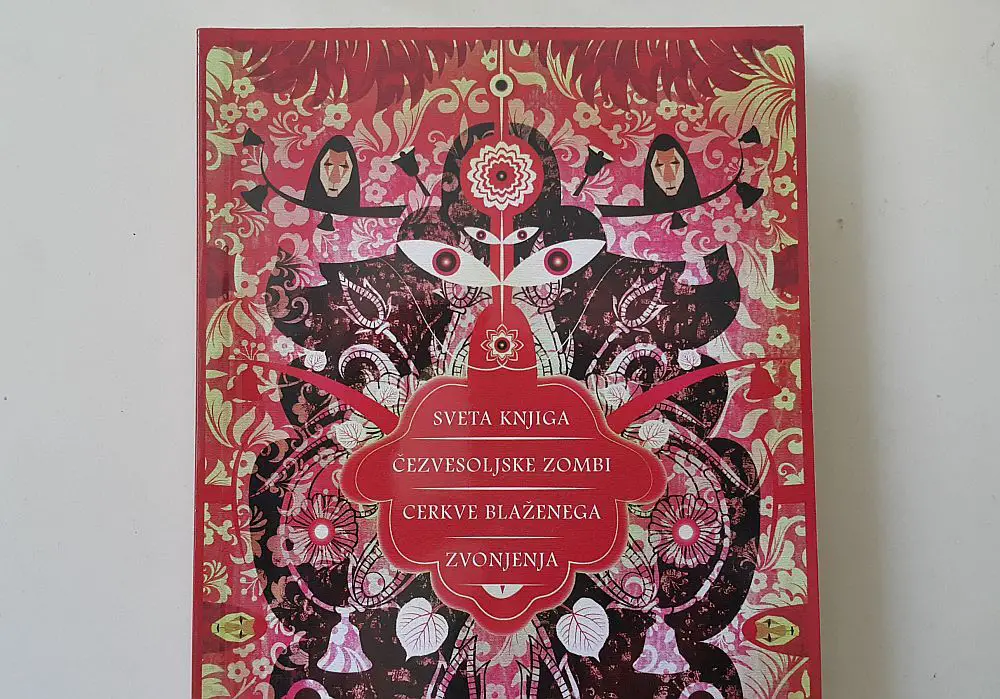
A compendium of articles, dogmas, gospels, revelations and other truths explains what the Church is all about and also forms the basis for theological contemplation of its followers.
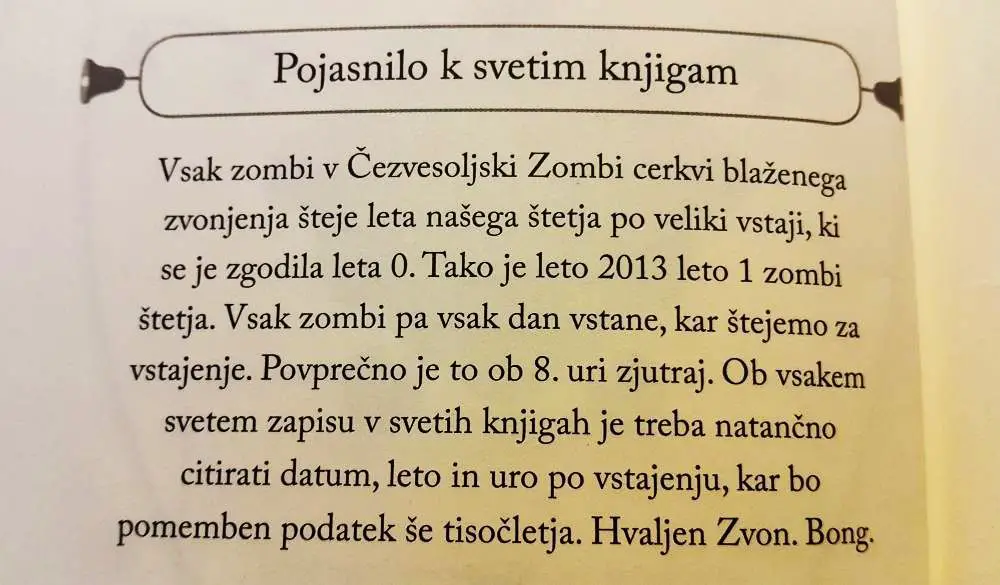
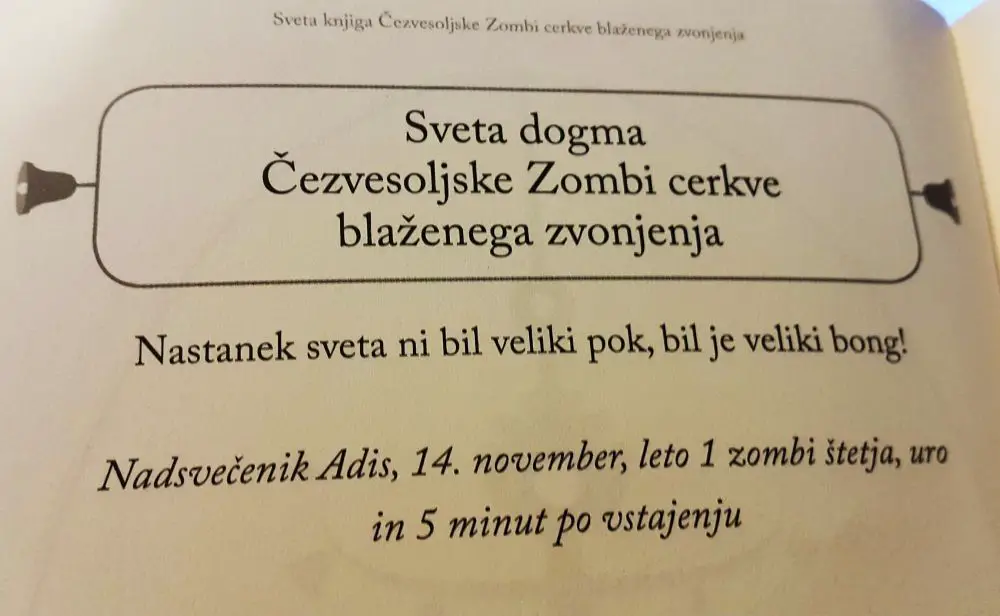
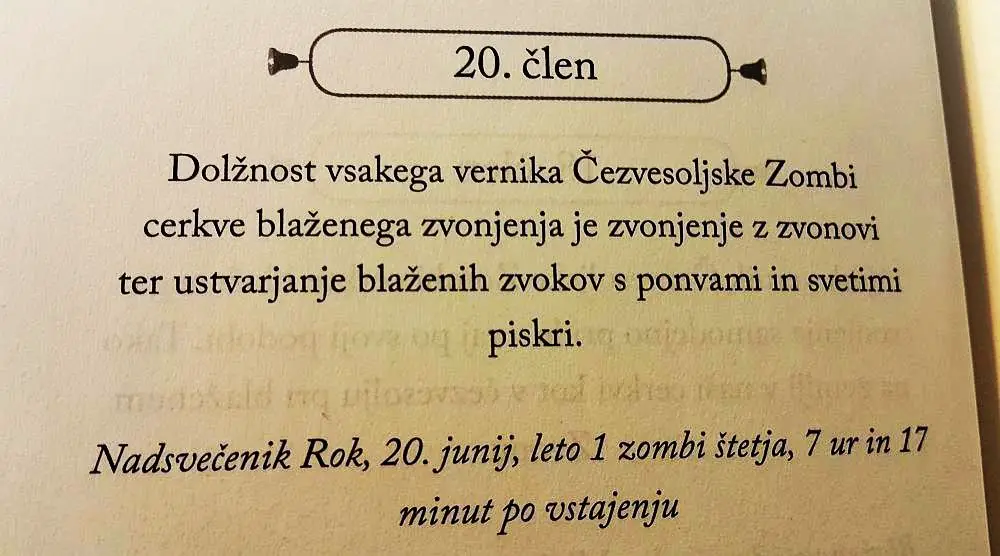
Translation: Article 20; Every Trans-universal Zombie Church of the Blissful Ringing believer’s duty is ringing bells and creating blissful sounds with pans and holy pots. (Archpriest Rok, June 20, Zombie Year 1, 7 hours and 17 minutes after the resurrection)
But is there an afterlife? The church believes there is.
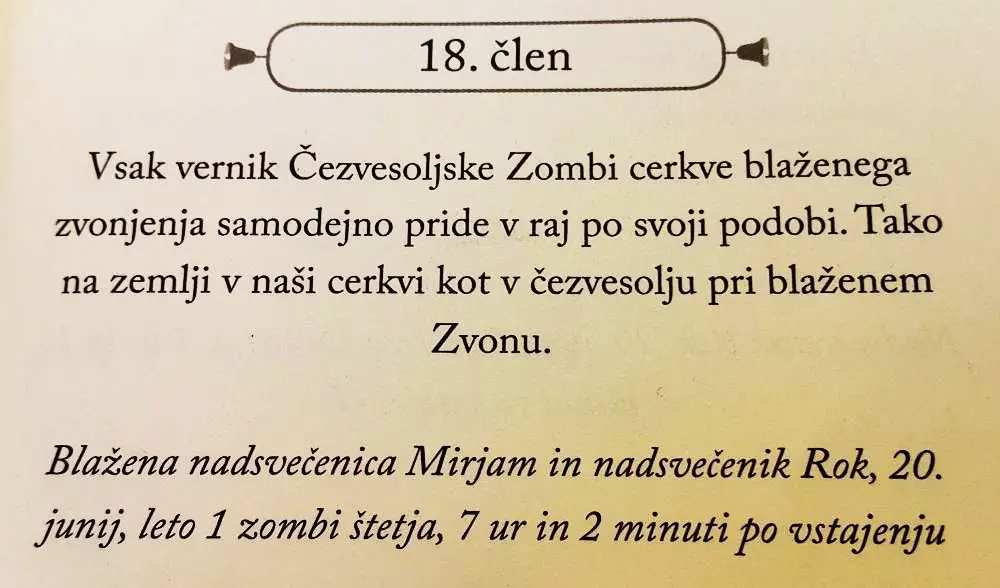
It was later explained that going to “Heaven in their own image” means that Heaven is what each of the undead considers it to be. If for someone Heaven is a Rammstein concert, that’s where they will end up after they die. Also, there is no Hell.
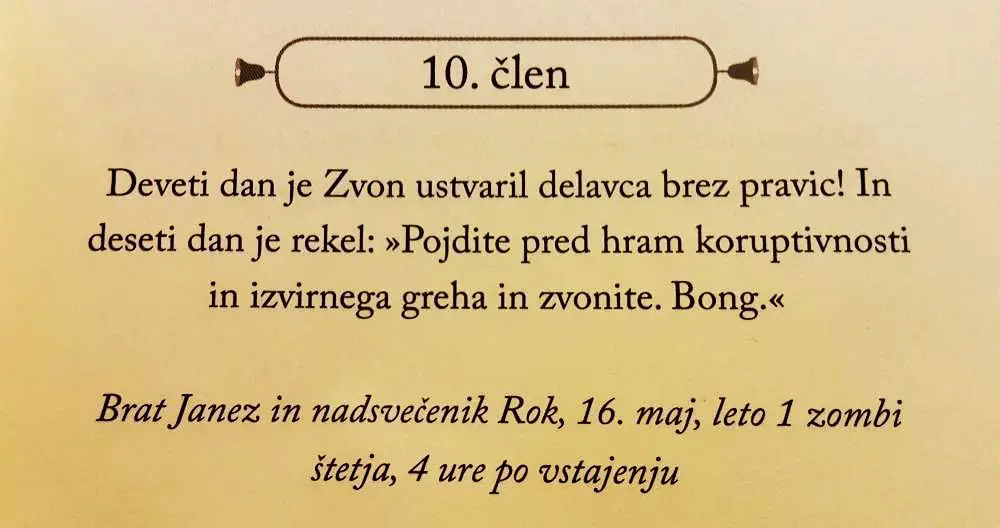
As it turns out, the Temple of Corruption and Original Sin actually means the National Assembly Building (i.e. Parliament). In the early years of its conception, the church held its holy mass in front of the Parliament building every Wednesday, while at the same time collecting donations in clothes and food for the Red Cross and Slovenian Association of Friends of Youth.
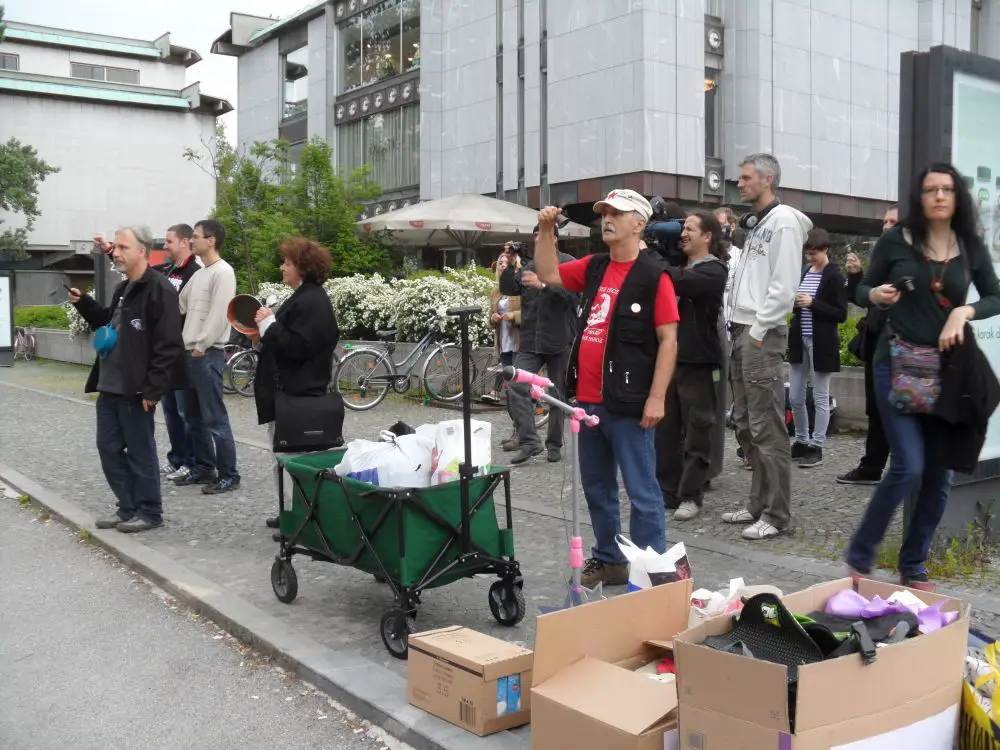
The new Church was met with a mixed response from the public.
A sociologist of religion Marjan Smrke, for example, stated for Delo, that the church is more of a parody of religion than a religion, but that such parodies are as old as religion itself, citing Roman Catholicism as a parody of original Christianity as an example. According to Smrke, the Zombie Church belongs to a new generation of parody religions, such as Pastafarianism and Jediism.
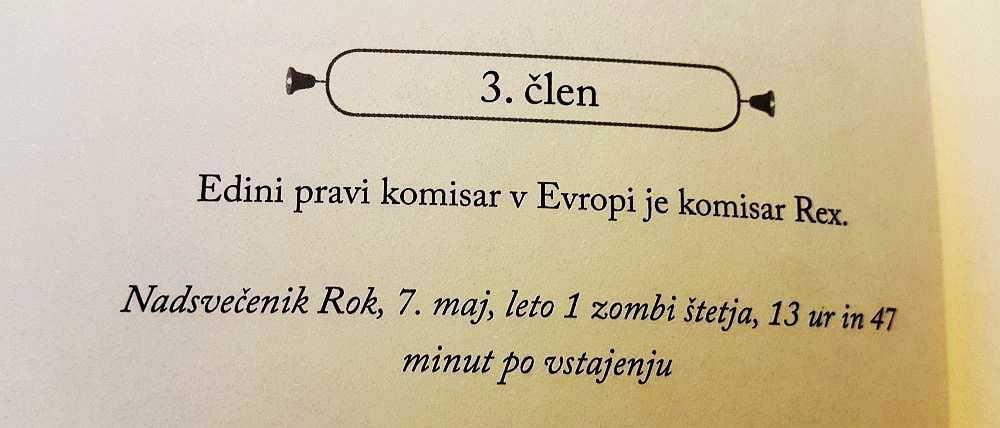
The Ministry also received a protest letter from the Catholic Institute for Family and Culture of Life (KUL), who expressed offence at the Ministry’s decision to register the Church, claiming that the Zombie Church was in fact a “nonreligious” community. KUL saw the recognition given to the Church as part of the Minister Uroš Grilc’ broader “Christianophobic” plot: “In accordance with the secular doctrine of a hateful attitude towards religious communities, with the aforementioned registration the Minister encourages public mockery of religious communities and the spread of prejudices against religion and religiousness in general.”
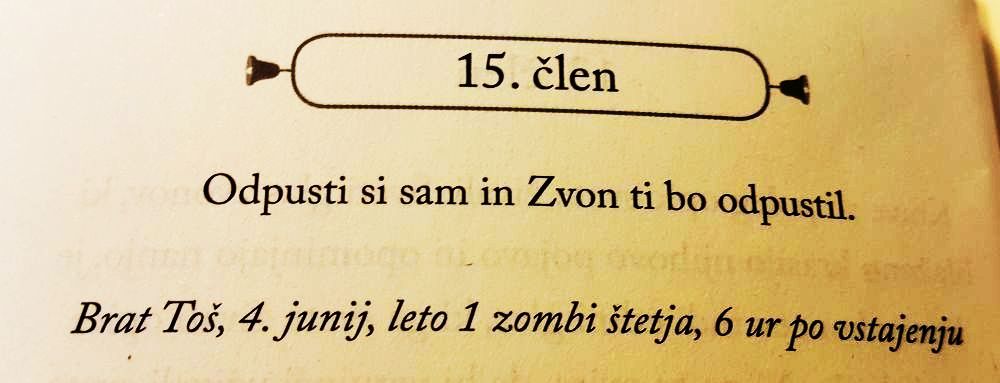
Gregor Lesjak, the director of the Office for Religious Communities, also replied to KUL’s complains that a joke religion was added to the list of the true religious communities. In an article by Delo, Lesjak was quoted emphasizing that the Zombie Church met all of the required criteria and explained that the law does not call for verifications of “religiousness”.
The problematisation of religiousness with the emerging new religious communities rests, according to Lesjak, on three misconceptions. The first misconception is a belief that the State is a guardian of the sacred: “The State is not the guardian of the sacred, religious communities are.” Secondly, the registration does not mean that the state issues a certificate indicating that the group’s religious teachings are genuine, appropriate or true. Gaining and keeping the trust of their followers is something that rests with the religious institutions themselves. And thirdly, it is not State’s task to tell its citizens what kind of things are good or bad to do, like a mother would tell their child. The State offers its citizens various legal forms of organisation under equal terms. If it turns out that a group of citizens has chosen a form of organisation that hindered the development of their own plans, the responsibility for that rests entirely with the group, not the State.
In an interview for MMC, Rok Gros, Archpriest of the Zombie Church and the Keeper of the Pot and Pan, didn’t deny the similarity with the Pastafarianism, being quoted as saying “we don’t discriminate against anyone. Members of any other religion are welcome in our church, Pastafarians included.” However, he strongly denied that the Church was making fun of anyone, or that the Church was not a real one.
For Sobota info, Gros stated that “Calling us a parody is one of most serious insults to us. We are a very serious church.”
We too had some questions for the Church, specifically how many members does it currently have, whether it gets any public funding and whether it is true that the Church has managed to spread to Croatia. The Church replied with the following explanations.
Bell willing!
Our church has 12,000 members.
We do not receive any public funding, despite the fact that even the court decided that the Ministry of Health violated legislation by religious discrimination for not granting our pro bono clinic in Nova Gorica a status of humanitarian institution, the legal basis for bids on tenders.
In Croatia we have Archpriest Domagoj I the Lionheart, who takes care of spiritual needs of our believers in Croatia (marriages, holy masses…)
Best regards and Bell be with you.
Bong
Archpriest Rok, founder, Keeper of the Pot and Pan, July 1, 7 Zombie Year, 3 hours and 4 minutes after resurrection
For more on Trans-universal Zombie Church of Blissful Ringing, click here for its webpage, where you can also join.
STA, 3 July 2019 - A Slovenian project focussing on the river Ljubljanica has received a UNESCO award for best practice in underwater cultural heritage, and archaeologist Andrej Gaspari has been honoured with the appointment to a UNESCO advisory board, the public broadcaster's news portal MMC has reported.
The project focused on underwater research, the conservation of a dugout boat from the 2nd century BC, remedial work on the riverbanks and monitoring, among other things.
It culminated with the Ljubljanica River Exhibition in the town of Vrhnika, which is dedicated to the natural and cultural heritage of the river and its surroundings.
Ljubljanica, declared a cultural monument of national importance in 2003, is one of the most important but also one of the most at-risk archaeological sites in Slovenia.
According to MMC, there are plans to have it placed on the UNESCO list of natural and cultural heritage.
The project was conceived and led in 2014-2016 by Irena Šinkovec from the Ljubljana Museum of Galleries in collaboration with the Vrhnika municipality, Ljubljana's Biotechnical Faculty as well as domestic and foreign experts.
Meanwhile, Andrej Gaspari, head of the archaeology department at Ljubljana's Faculty of Arts, was elected a member of the Scientific and Technical Advisory Board.
He is credited with laying the foundations of advanced underwater archaeology in Slovenia.
The two recognitions came on 21 June as part of the seventh conference of signatories to the Convention on the Protection of the Underwater Cultural Heritage in Paris.
Slovenian ratified the 2001 convention in 2008.
Related: See the Charms of Ljubljana from a New Angle with a Barka Boat Ride
If you live or even just spend a little time in Ljubljana you can't help but be struck by the vibrant arts scene, both in the formal sense of galleries, large and small, but also in the street art and style that make the place such an attractive place to hang out in. In that context, and with a little money in your pocket and bare walls at home, you may be wondering: where can I buy some Slovenian art? One man who has answer to this question, and many more about the local art scene is Damjan Kosec.
Damjan and the SLOART team have at least two long-term plans. One is related to his studies, in computer science and artificial intelligence, where he's working on his PhD in Ljubljana, following a line of research that we'll no doubt be covering at a later date on this site. The other, and the focus of today's story, is project that started more or less in 2005, when became interested in the local art scene, and which has grown steadily since then.
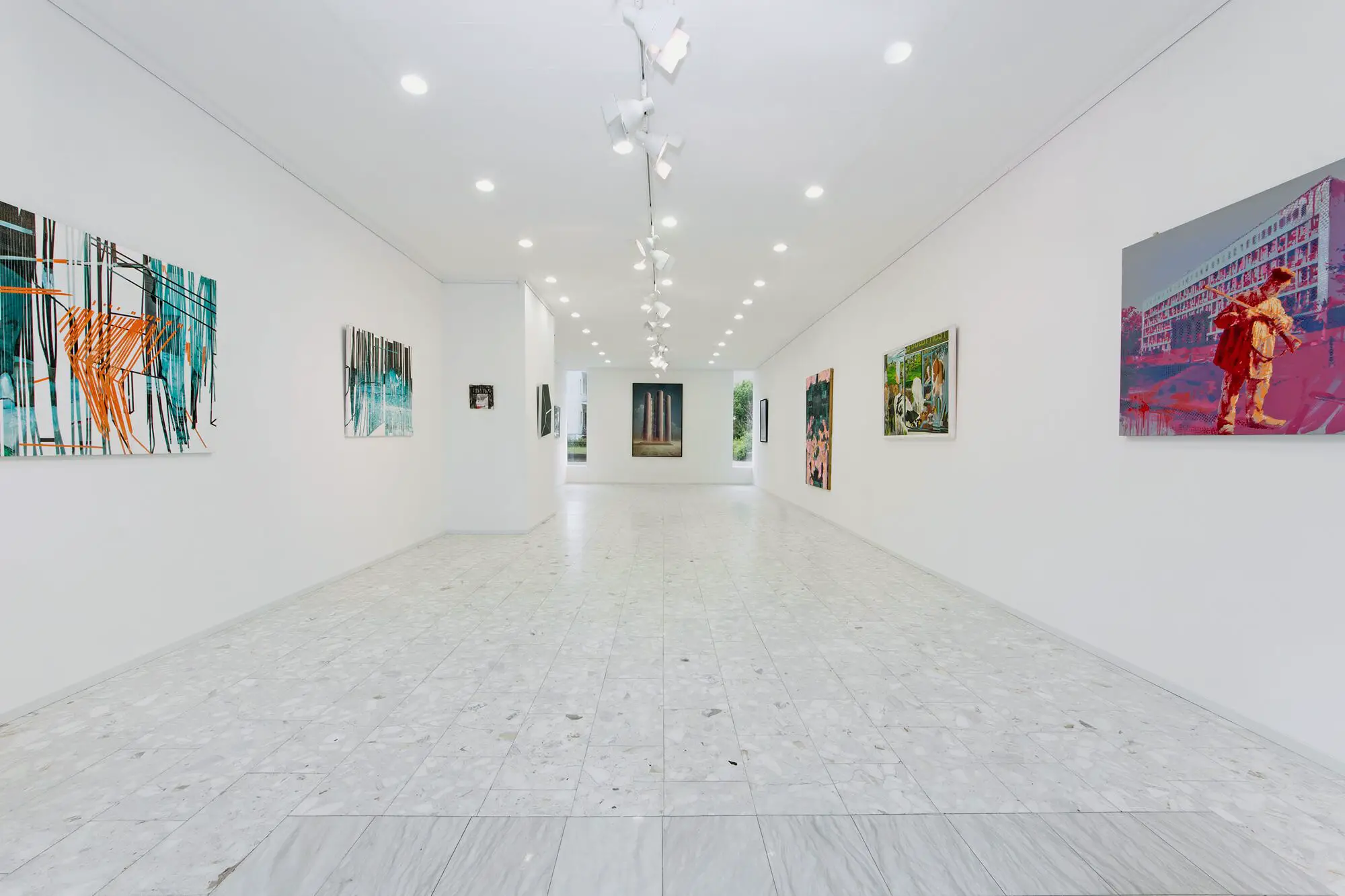
Inside the space on Trubarjeva cesta
The current incarnation of this interest – which is itself composed of at least 16 different projects, six of which have now been realised, with the remainder due to come online by 2025 – is called SLOART. In brief, this aims to connect Slovenian artists with buyers and collectors, using both an online platform and brick-and-mortar gallery, a new version of which has just opened at the funky end of Trubarjeva cesta, opposite the always under-threat Rog squat.
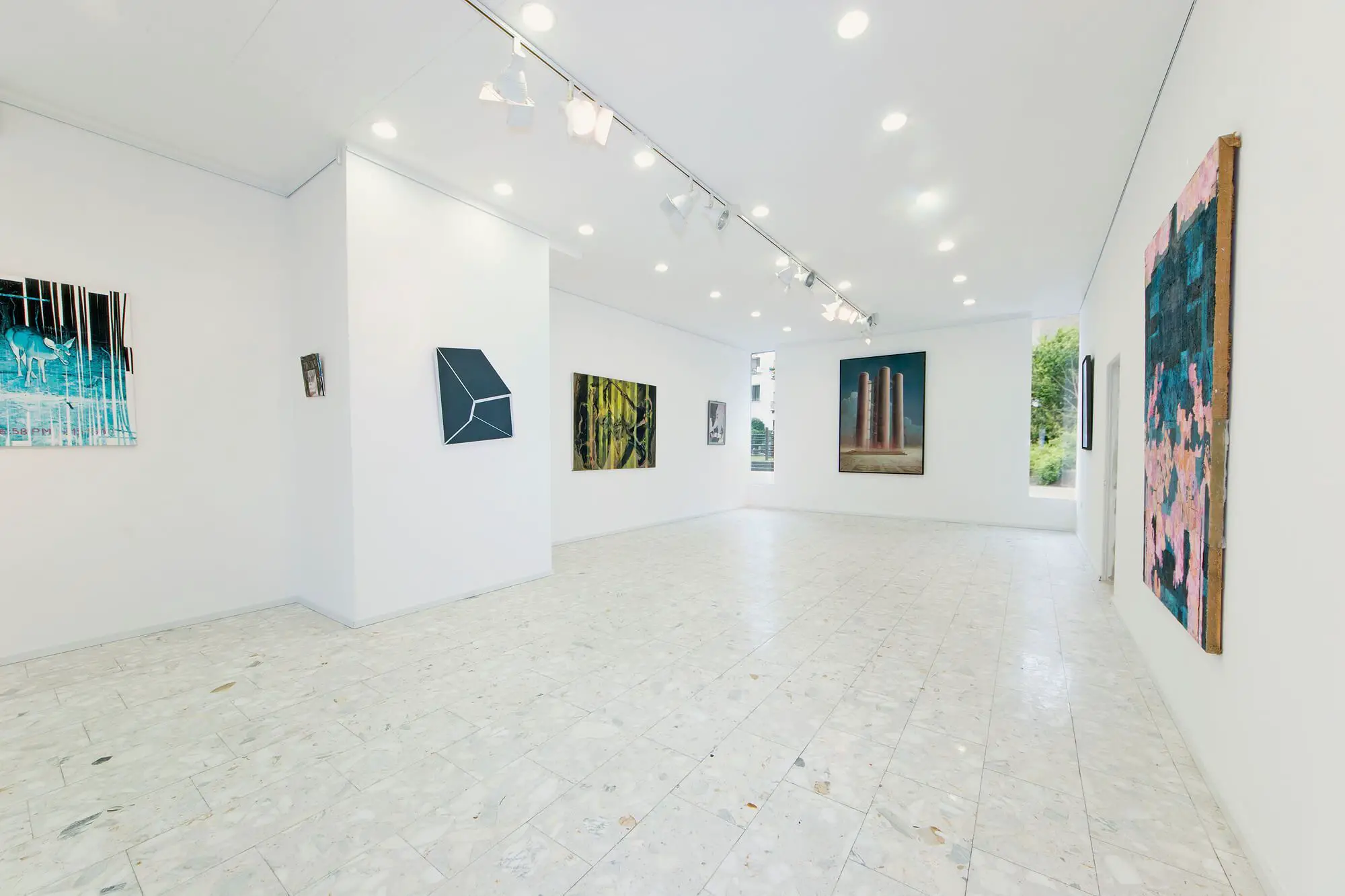
Inside the space on Trubarjeva cesta
It offers works from 1800 to the present day, and even just a passing familiarity with the biggest names of Slovenian art, as seen in the National and Modern Galleries, will make clear what an impressive list of names SLOART offers. Names such as Drago Tršar – the subject of a major retrospective earlier this year, and the man behind many of the most well-known sculptures in Ljubljana; Hinko Smrekar – who did the illustrations for much-loved edition of Martin Krpan; Zoran Mušič – who has his own room at the National; or Rihard Jakopič, the leading Impressionist who founded the school that would go on to become the Academy of Fine Arts at the University of Ljubljana. Beyond the dead there’s the living, with exciting works by current artists with years of work and discovery ahead of them.
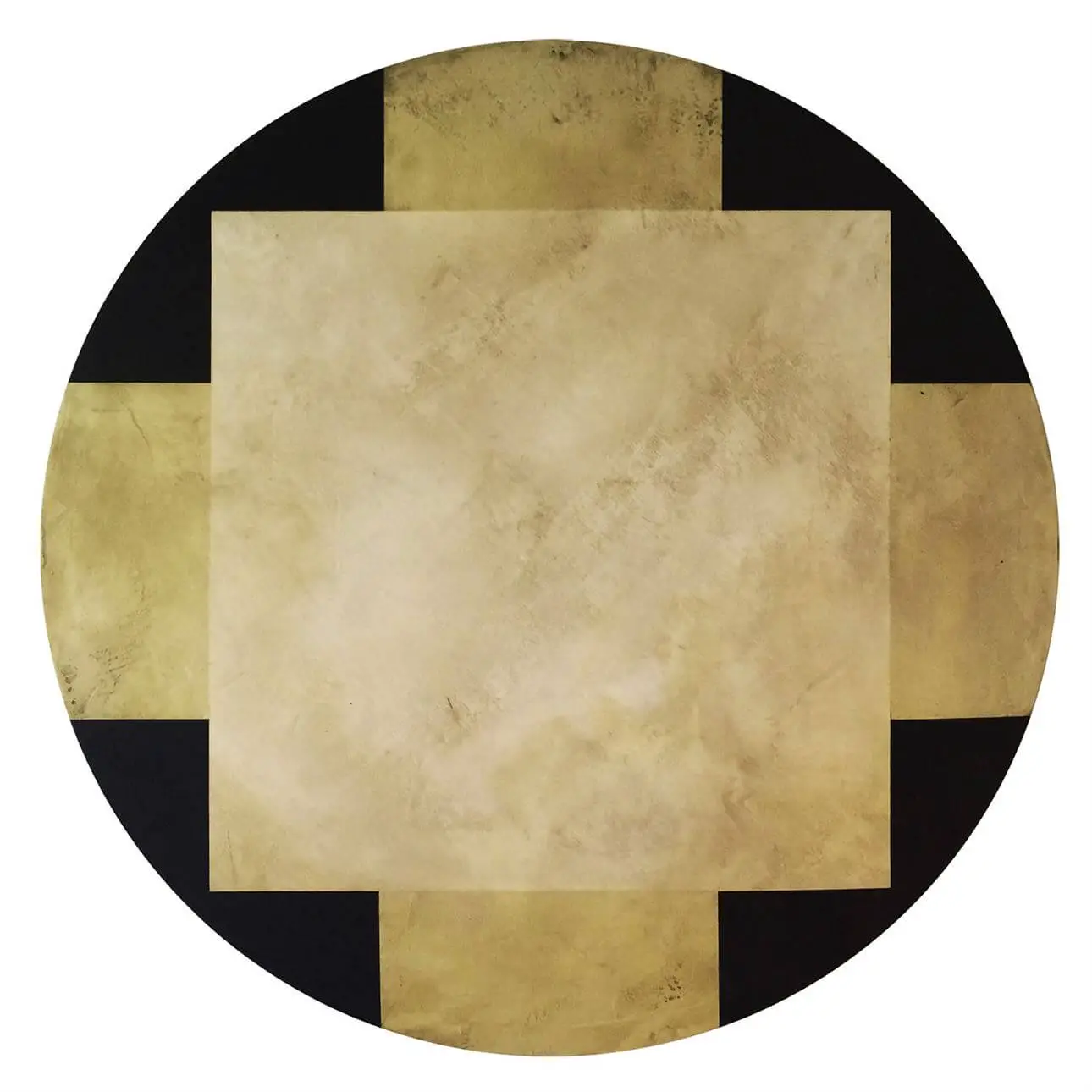
Duša Jesih - Menage a trois, Acrylic on canvas, 100 cm x 100 cm, 2015
But how is SLOART different from any other gallery? Since the offices of TSN are currently located in the corner of a bedroom on Trubarjeva cesta, nestled between a window and closet and less than 100 metres from the new establishment, I went along to learn more. I didn't record the conversation because the art world is full of stories you won't hear with a device in your hand, so while none of this comes from direct quotes it’s an abbreviated version of our conversation, based on notes and sent back to Damjan for approval.
What’s the main problem with the local art market?
Ten years ago the Slovene art scene, in terms of buyers and sellers, collapsed. There were a lot of scandals, few ethics and an overall lack of transparency. Art was, for example, used to commit fraud laundering, so an appraiser would get sent an email with a picture attached and value it for millions, no questions asked. Even without such obvious criminal actions, the market was too small, too unknown, for buyers to have much confidence. Moreover, if they did make a purchase then very often they were being ripped off, being sold a work at three times what the artist should have been commanding, based on previous sales, exhibitions, and so on. This led to a very bad first experience for many buyers here, and so they never returned to the market.
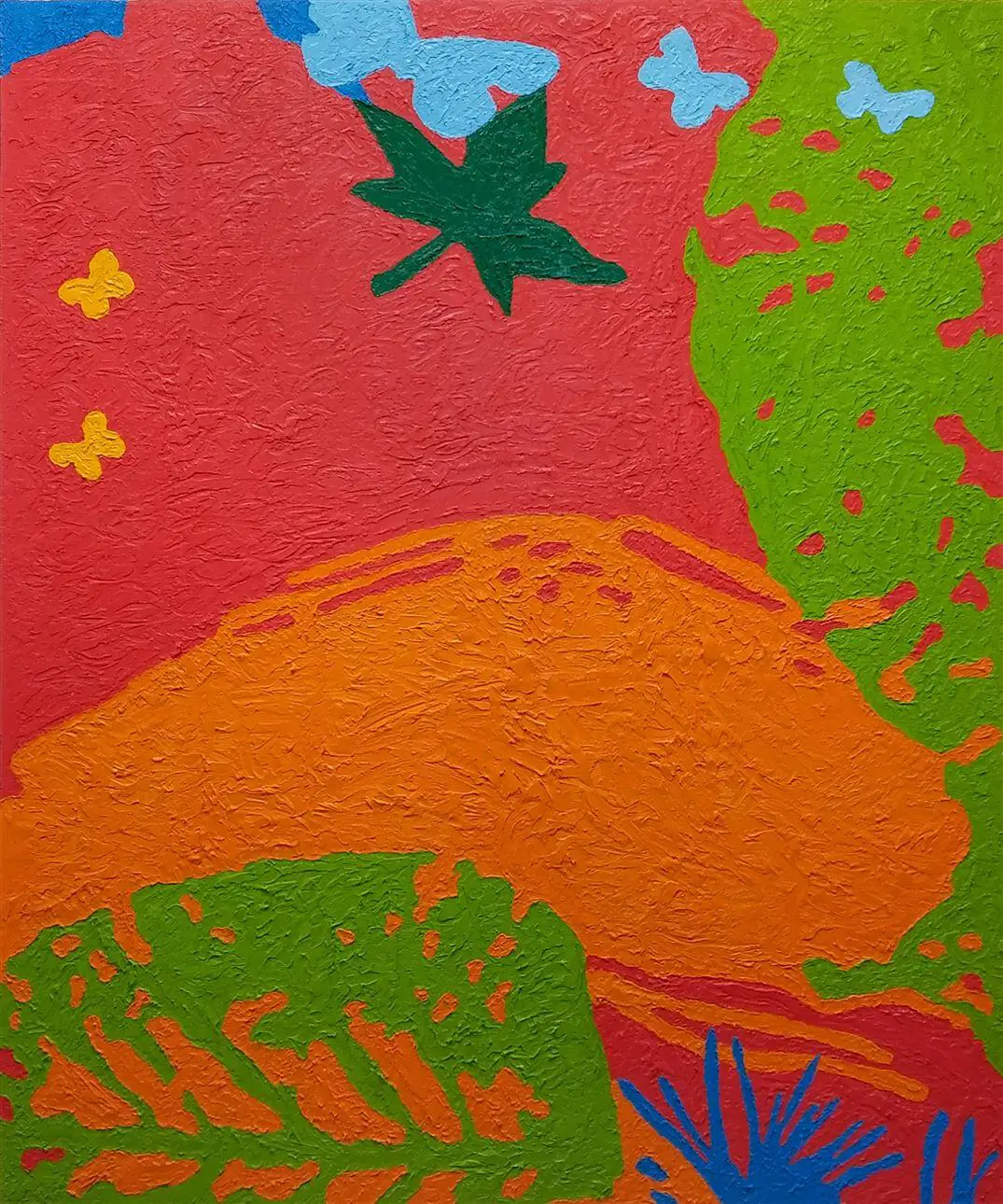
Arjan Pregl - Butterflies, Oil on canvas, 120 cm x 100 cm, 2017 - 2018
And what does SLOART do to change this?
My main goal is to grow the market here, and that can only come with the right ecosystem. So, for example, one of the projects we have that should launch next year is ArtIndex. This will be a database of Slovenian artists, where you can find details of their resumes, and so on. But more than that, it'll have records of the prices paid for their work, plus a system whereby they'll get points for how many exhibitions they've had, and where. Based on this people will be able to have some idea of a fair price for the artist's work, making the whole thing more transparent and returning some confidence to the market. More than that, though, we'll use AI along with a group of art experts to predict where the market might go for a particular artist.
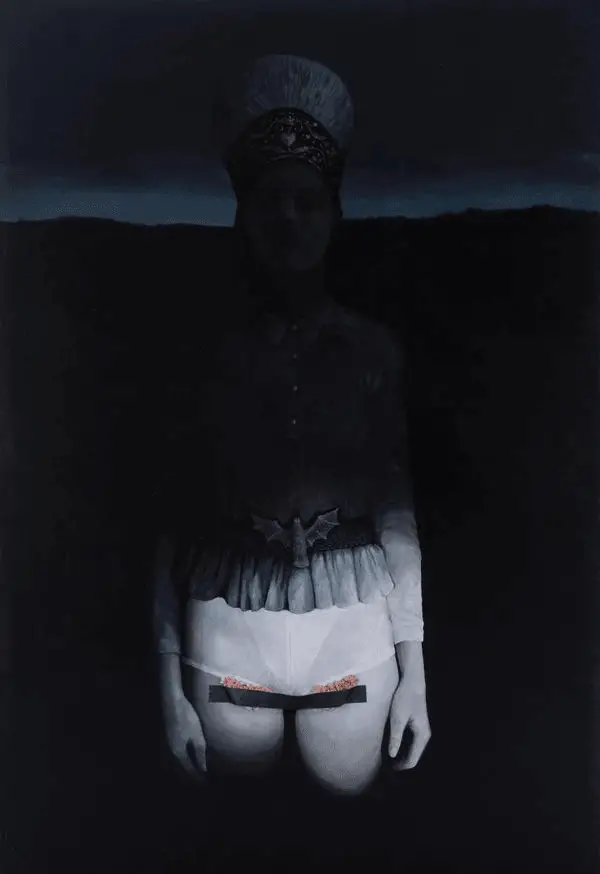
Tina Dobrajc - This is bat country!, Acrylic and artificial flowers on canvas, 305 cm x 155 cm, 2014
We also want to develop artists careers in a more active, collaborative way. A new project we have is Gallery Y (pronounced “epsilon”, not “y”), which is also in the same space here [Trubarjeva 79], and we plan to open another gallery in the centre of town sometime next year. The idea here is that we'll choose, say, 10 outstanding Slovenian artists in 10 years and showcase their work, really try and help them break through on the international scene.
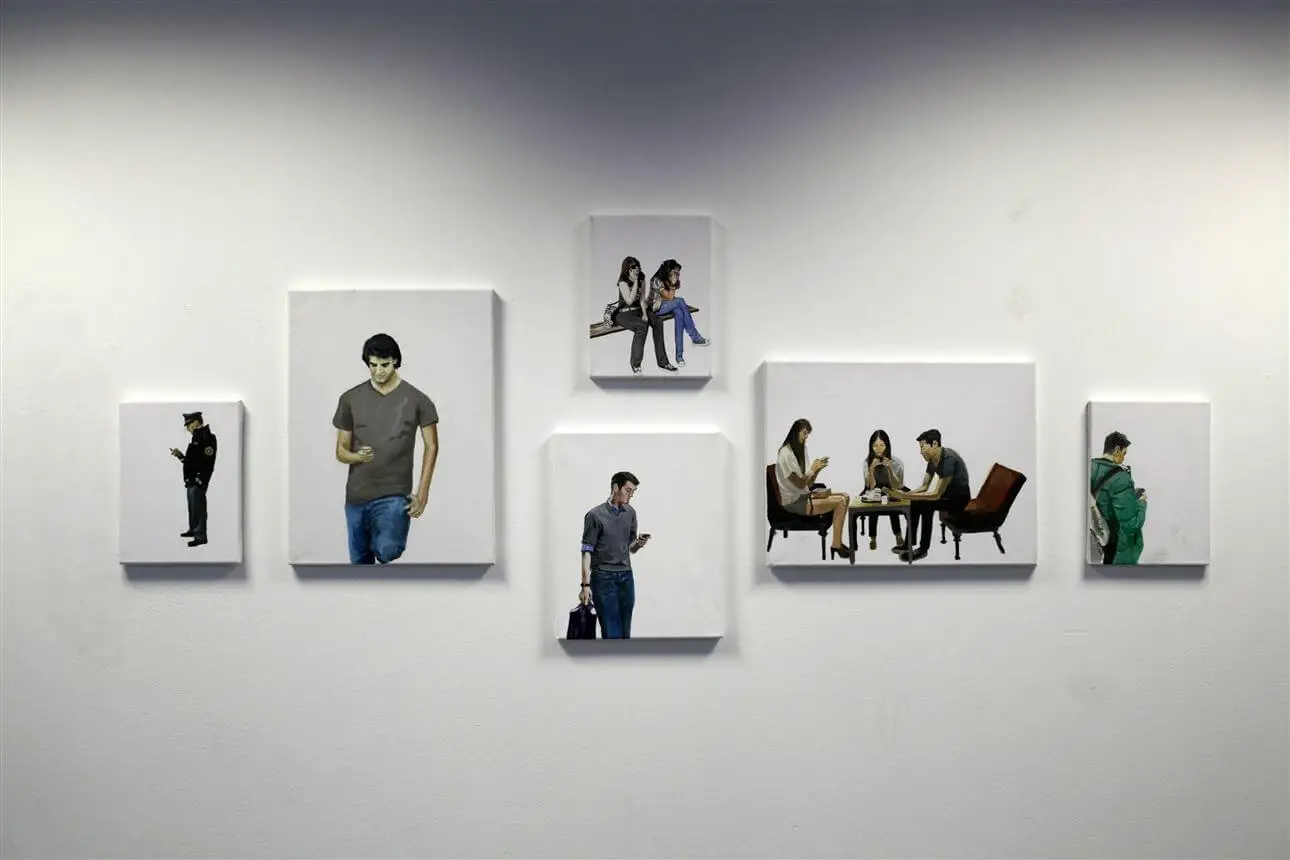
Sašo Vrabič - Smartphones, Oil, acrylic on canvas, 6 artworks: 24cm x 40cm and 18cm x 30cm
What are some of the practical problems artists face here?
Mostly it’s difficult for an artist to make money, to support themselves from their work, so there's a constant need produce and sell. And this can be a real existential crisis, in the sense that the means of your existence are always under threat, even if you make regular sales. The government could do more in this regard, especially to help artists who are just starting out in their careers. But even with all that, Slovenia has a lot of very talented, dedicated artists, and I’m convinced that once trust and transparency have returned to the market it can attract more serious collectors, or just people who’d like some Slovenian art for their homes, because right now the market is very undervalued.
You can see more of the works on offer at SLOART on the website, or visit the gallery at 79 Trubarjeva cesta
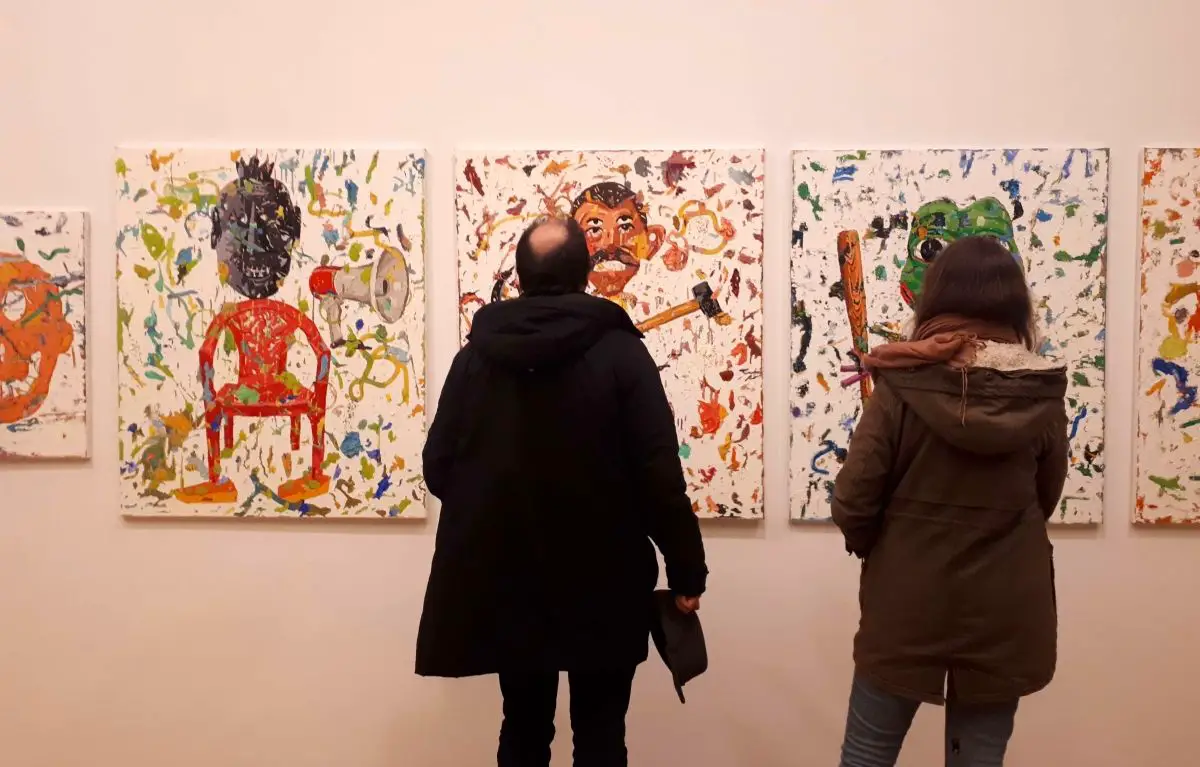
Some of Arjan Pregelj's works at the Moderna Galerija. Photo: JL Flanner
Related: Ljubljana's Modern Gallery Highlights Recent Painting in Slovenia
STA, 27 June 2019 - An exhibition on famous Slovenian architect and designer Jože Plečnik (1872-1957) and his designs of sacred objects opened in the Vatican Museums on Thursday evening, featuring 33 selected liturgical vessels as well as video presentations of his sacred architectural works.
Related: Playful and Austere - A Visit to Plečnik's House in Ljubljana
The opening was attended and addressed by Prime Minister Marjan Šarec and Culture Minister Zoran Poznič.
Šarec said at a reception for Slovenian Statehood Day, which followed the opening of the exhibition, that Slovenia should be proud and happy as this was the first Slovenian exhibition in the Vatican.
"Jože Plečnik is the greatest son of Slovenian architecture. He was a deeply religious man, which is perhaps less known, and it is not a coincidence that he created objects which we admire today."
Minister Poznič said that it was one of the largest events in culture this year. "The exhibition tells us how our artist, master Plečnik, associated the spiritual and material works in his work," he was quoted by the Culture Ministry.
Labelling Plečnik as one of the greatest men in Slovenian cultural history, the minister said that the "exhibition is an exceptional opportunity, serving as a booster of what sometimes we as a society lack - self-confidence."
Barbara Jatta, the director of the Vatican Museums, is happy that Pinacoteca Vaticana is hosting an "important exhibition of sacral objects by Jože Plečnik, a great architect and designer of the 20th century".
"Plečnik created an original and innovative style, which shows both in his church architecture and in the field of liturgical vessels," Jatta was quoted by the Ljubljana Museum and Galleries (MGML).
According to Peter Krečič, an expert on Plečnik's life and work who arranged the exhibition in cooperation with the Plečnik House curator Ana Porok, Europe and the world truly discovered the greatness of the architect's opus after his work was presented at the Paris Pompidou Centre in 1986.
Primarily famous for being an architect and urbanist, he was also a great designer, with his work being mostly showcased in three European capitals - Vienna, Prague and Ljubljana.
He established himself at the beginning of the 20th century by designing the famous Zacherl Palace in Vienna, then moved on to renovating the Prague Castle and its vicinity, transforming them into the symbol and political centre of a modern democratic state.
Plečnik also turned his hometown Ljubljana into a modern capital, having designed iconic buildings and spaces there.
Encouraged by his brother, who was a priest, he started designing liturgical vessels in 1913, including chalices, ciboria and monstrances, thus revolutionising traditional concepts of such design by introducing modern, clear lines and simple decoration featuring gemstones.
Designing the vessels, Plečnik drew inspiration from the art of sculpture, which makes those designs stand out and provides that transcendent aesthetic value which is essential to experience the sacred, according to Krečič.
The exhibition, entitled Plečnik and the Sacred, has been put on by the MGML in cooperation with the Slovenian Embassy to the Holy See, the Culture Ministry, the Ljubljana Archdiocese and Vatican Museums.
According to the MGML, Plečnik is the first Slovenian artist whose work will be showcased at the Vatican Museums. The exhibition will run until 7 September.
On Wednesday, Pope Francis received sculptor and painter Miko Simčič, the author of a one-tonne bust of the pope, made of Carrara marble, and standing on a pedestal made of two-colour Hotavlje marble.
Simčič said he had made the bust with the pope's approval, which he sees as a great honour, as Pope Francis had so far been rejecting the idea. The bust will be housed in the Vatican, and the artist wants to make more of them and give them to various cathedrals around the world.
You can learn more about the exhibition here
June 21, 2019
After attending last week's London release of Exploring Extraordinary, a book that explores the history of Rolls Royce and Bentley and also features the work of Mateja Benedetti, the designer's latest venture, Benedetti Life, has now launched both an online store and showroom in Ljubljana.
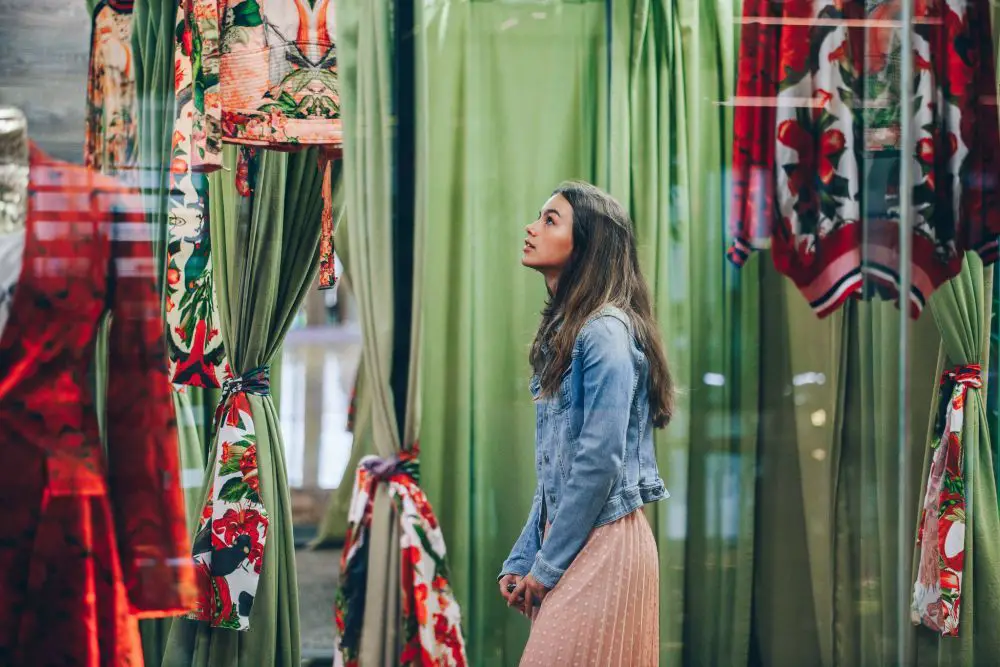
Online preorders can be made for Benedetti Life's Parrots' Poetry collection, which the firm sees as a way to reduce overstocking and therefore avoid potentially unsold items that then become textile waste.
Starting this Monday, June 26, 2019, customers will also be able to place made-to-measure orders from the collection with a Morro Sartoriale tailor.
The Benedetti Life showroom opening, at Kristalna palača in BTC City, was hosted by the always positive and friendly Manca Košir, the Slovenian author, journalist and environmental activist, and Moda Mi&Lan and Morro Sartoriale label CEO Milan Mörec.
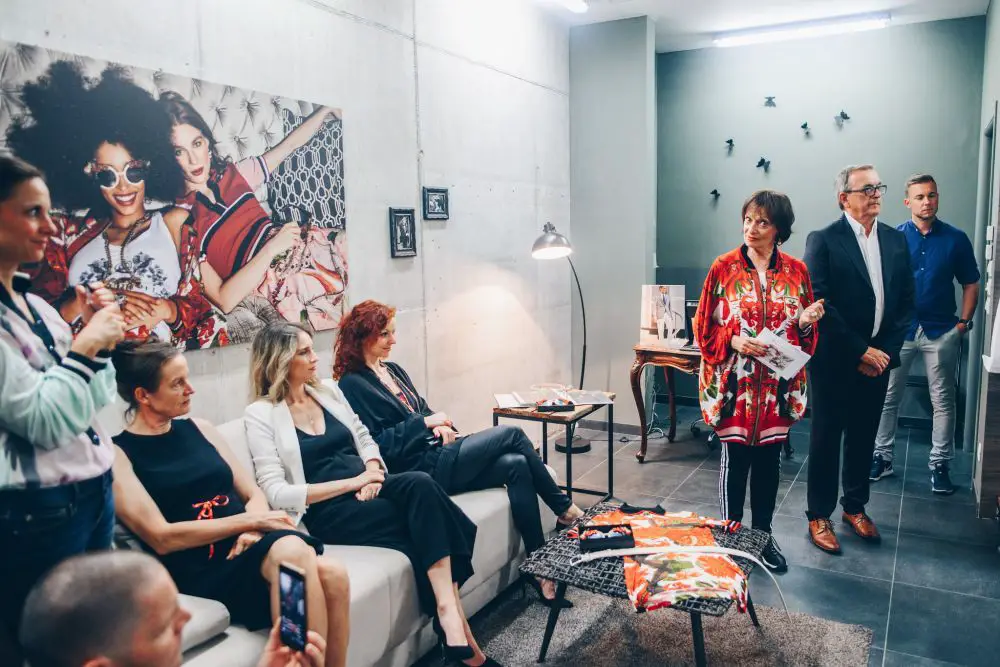
Benedetti Life is a sustainable and animal-free luxury fashion label, founded by the award-winning designer Mateja Benedetti. The Benedetti Life fashion line was created in response to mounting reports on the devastating impact fast fashion has on the environment, animal and human wellbeing.
Mateja Benedetti
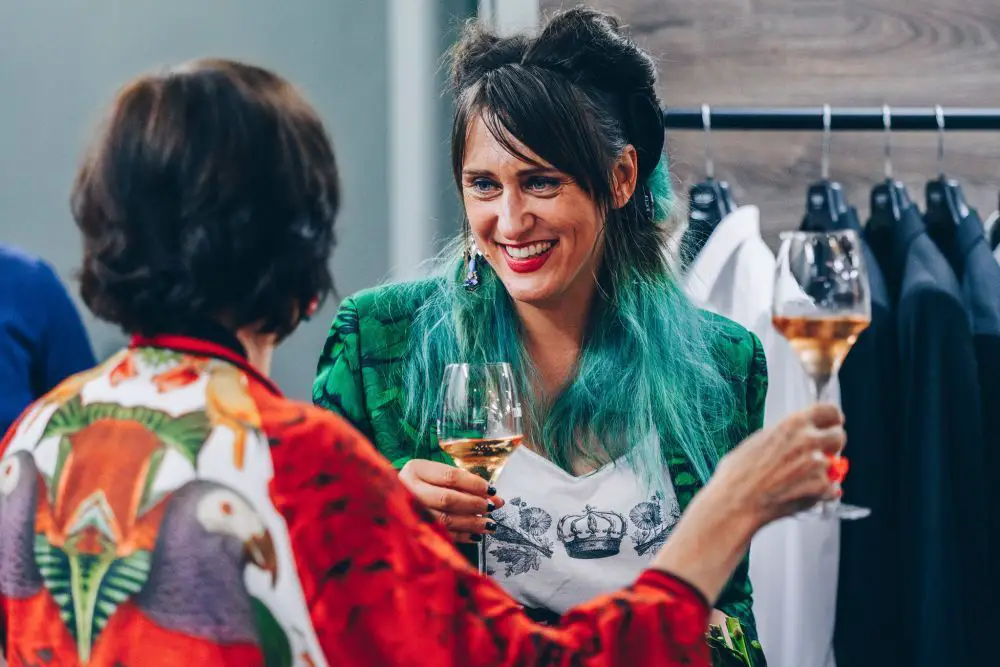
Mateja Benedetti, a Slovenia-based fashion designer, started her career as a costume designer for opera houses and theatres, her works being featured all over the world, including Milan, Paris, Los Angeles, Kuwait, and Singapore, among other locations. In 2014, she launched her first sustainable fashion brand and Vogue Italia selected it as one of the TOP 20 most promising eco-friendly clothing brands in the world that same year. In 2017, Mateja made it among the five finalists at the Green Carpet Award, conferred at Teatro alla Scala during Milano Fashion Week. The renowned Suzy Menkes interviewed her for International Vogue in 2017, and Livia Firth selected her apple-skin gown for a Grazia photoshoot, published the same year. In 2018 she received the Positive Luxury and the Big See Awards. Mateja’s work has recently been featured in book Exploring Extraordinary, commemorating the 100th anniversary of the carmakers Rolls Royce and Bentley.
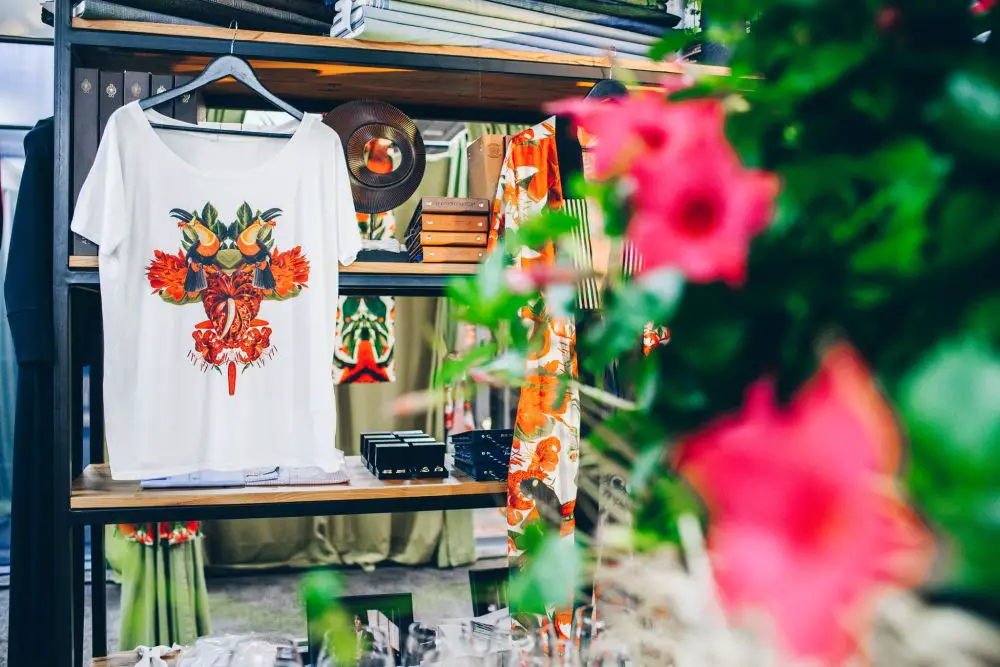
Benedetti Life uses only non-toxic and organically grown textile materials, makes its clothes locally, in line with fair trade and decent workers’ conditions, and guarantees no animals were abused in the process of garment creation, be directly or indirectly through the environmental destruction. By its high ethical standards and constant search for new material and productive solutions Benedetti Life sets the bar as high as it gets. Responsibility driven innovation combined with luxury fashion design results in skin-friendly, timeless creations inspired by life and nature.
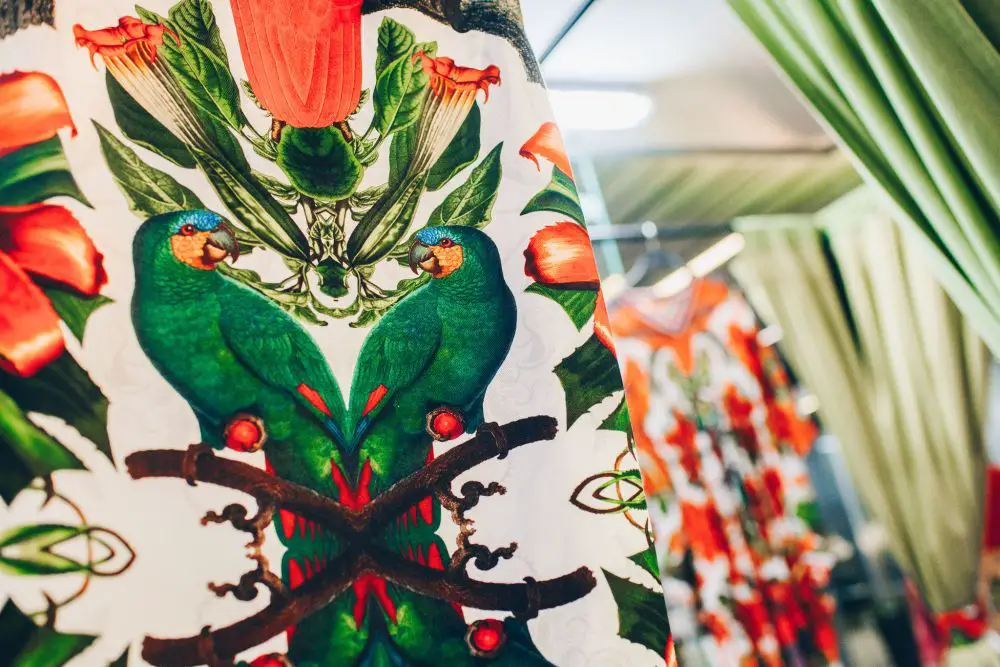
Parrots’ Poetry Collection
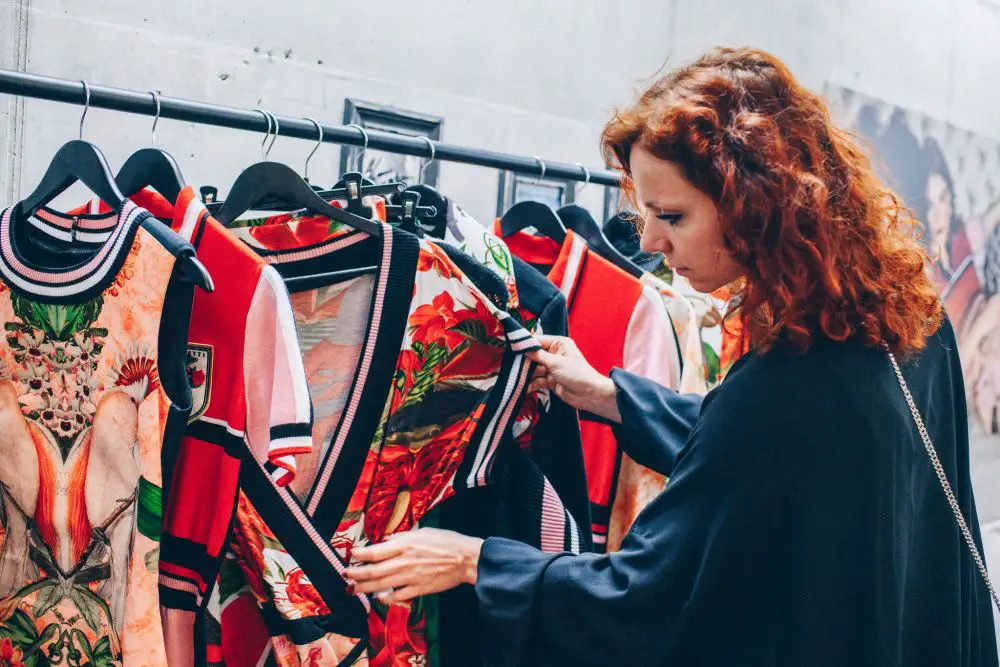
Each Benedetti Life collection explores an animal species under threat due to the destruction of their natural habitat, hunting and climate change. It aims to celebrate the creatures’ beauty in garments, and raise awareness of the threats and related solutions that would improve their conservation status. Parrots have served as human inspiration and companions since at least Roman times. Today, many of the existing 387 parrot species are endangered, with some on the verge of extinction, due to destruction of their natural habitats and the persistence of illegal trade in wild-caught stock. These include some of the most beautiful and intelligent species, such as the big colourful Arinae from the New World, talking African parrots, cockatoos and the flightless Kakapo of the New Zealand.
Benedetti Life captures the beauty of these birds in its clothes not in cages. In the process maximum concern is placed on protection of the environment and people involved in the manufacturing process.
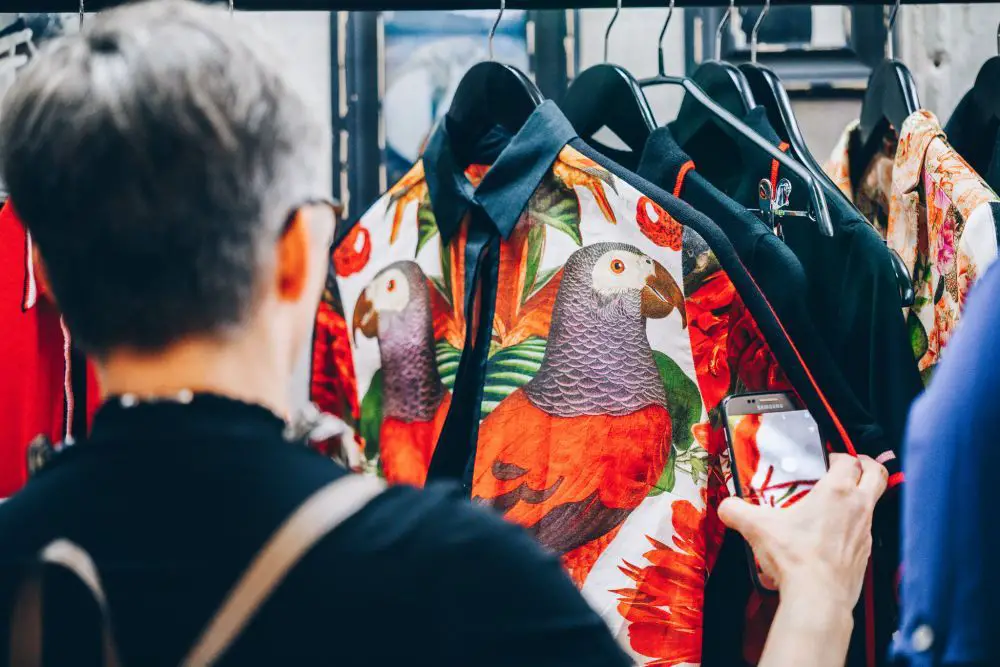
Wood Stock by Benedetti Life
In collaboration with the Slovenian Wood Stock Eyewear brand, Benedetti Life also presents the Wood Stock by Benedetti Life sunglasses line.
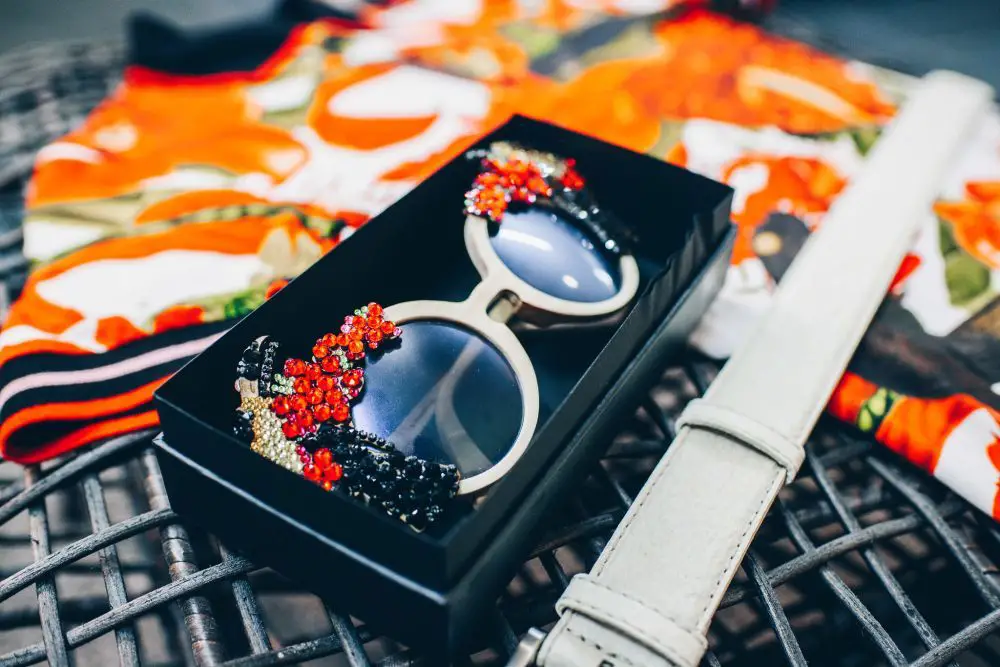
Wood Stock is a name that stands for environmental responsibility and excellence in craftsmanship. Wood Stock’s wooden sunglasses are not only locally produced but handmade by the skilful master Jaka Jančič himself, while high quality lenses are provided by a Slovenian lens producer Alcom. The frames of Wood Stock sunglasses are made of certified fair-trade wood. Once carved, the frames are then protected with skin friendly citrus oils and beeswax.
Wood Stock by Benedetti Life offers several designs that span from a straight wooden look to rich embellishments of birds, flowers and Swarovski crystals.
Morro Sartoriale
The Morro Sartoriale showroom, which is located in Kristalna palača at BTC City, Ljubljana is an exclusive host of the Benedetti Life showroom, where customers can order made-to-measure Parrots’ Poetry Collection designs with the Mi&Lan tailor every Monday between 8:00 and 11:00 and every Wednesday from 11:00 to 18:00. Bookings can be made by calling 070 669 669 or writing to This email address is being protected from spambots. You need JavaScript enabled to view it..
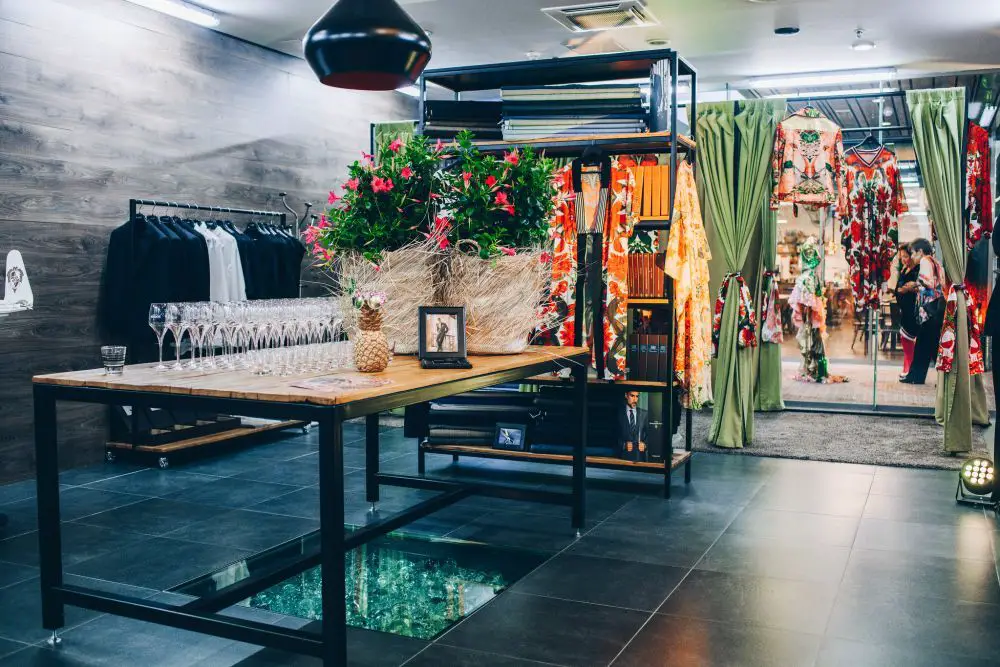
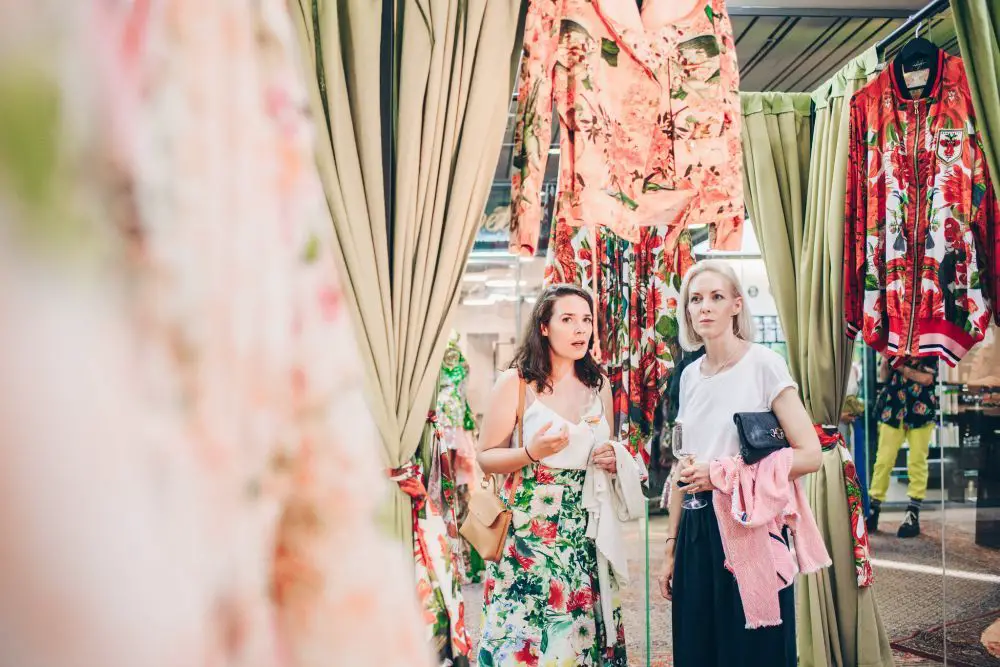
STA, 1 June 2019 - The US Food and Drug Administration has approved the first gene therapy to treat babies with spinal muscular atrophy, an innovative therapy that also involves technology developed by the Slovenian company Bia Separations.
The medication, Zolgensma, is manufactured by the US company Avexis, part of the Swiss group Novartis, using Bia Separations's purification technology.
Aleš Štrancar, the CEO of the Ajdovščina-based company, has hailed the approval of Zolgensma as Slovenian science's breakthrough among leading global strategic technologies.
Purification is a key process in production of medicines, in particular biological ones, because the active substance needs to be separated from other substances, which are often toxic.
The purification process represents up to 90% of the production costs of a drug.
Bia Separations's smart filters have become part of the therapy's registration, which means exclusive use of the Slovenian company's products for 20 to 30 years.
The approval makes Avexis a leading manufacturer of active agents for gene therapy, Štrancar said, adding that for Bia Separations this was a key reference project in the field.
"Our company is looking at the potential to generate more than 500 million euro in annual sales in a decade," Štrancar said.
He underscored that without this innovative gene therapy babies with spinal muscular atrophy would die before reaching the age of two years.
The medication replaces part of the flawed gene and after treatment the patients can live normally.
Štrancar noted that the therapy's approval is paving the way for development of active agents to treat rare genetic disorders in the short term, and to treat all types of disease in the long run.
STA, 1 June 2019 - The University of Maribor, cooperating with the Tekstina company and the Institute for Environmental Protection and Sensors (IOS), has set up a demonstration lab for chemical textile recycling which has already caught the eye of giants like Adidas, Nike and Decathlon.
The lab has been developed as part of the European project Resyntex, which is helping develop technology for the recycling of low quality textiles usually slated for incineration or waste repositories.
Resyntex involves 20 partners, including the three Slovenian ones which have launched a demo recycling line in Maribor. They see it as harbouring major use potential, as it is meant to enable new findings with regard to obtaining secondary resources from various types of waste, not only textiles.
Also immense are the marketing possibilities, given that EU legislation has brought very ambitious new waste recycling targets.
How can your old socks drive the #circulareconomy? @RESYNTEX can transform your #textile waste into glue, plastic, paint and other products, taking #recycling to new levels. pic.twitter.com/TIoJlEcbRd
— Martin Watson (@SWVisionsBE) May 22, 2019
"In June we are mostly offering these services to the project's partners, while as of 1 July the line will be available to all who wish to think sustainably," IOS director and Maribor Faculty of Engineering professor Aleksandra Lobnik told the STA.
"We've been engaged in many talks, but no contracts have been signed yet," she said, noting that many textile companies had committed themselves to sustainable development and would now also be bound to it though legislation.
Textile waste is being treated with chemical depolarization and enzymatic degradation. The project is extra valuable in that it is the first to also tackle textile mixtures, something not possible so far.
"Such textiles make up 94% of all textiles on the market," explained Lobnik, who is the project's technical director.
The lab allows the textiles to be broken down into basic chemicals. Cellulose is for instance used to obtain glucose and thereby bioethanol, an energy source, wool is composed of proteins that can be utilized in place of toxic formaldehyde used in wood-based panels, and synthetic fibres can be used to get fresh fibres for new textile or plastic products.
The total amount of waste textiles in the EU is estimated at 16 million tonnes annually, and "waste that now means costs can become profitable".
"What we have in Maribor is only a demo lab, which allows an optimisation of the process so that an industrial facility can be built later on," Lobnik said, explaining such facilities could process several tonnes of textile waste a day.
Along with placing the findings made so far on the market, IOS wants to further step up research with partners in the future.
"Textiles are not the only problem, there are large amounts of other waste, which is why we are already developing technologies meant to also include the decomposition of other types of plastic and materials," Lobnik said.
With its long history of growing juniper berries (brina) and distilling a juniper-based schnapps (brinjevec or brinavec), Slovenia has the culture and skills needed to produce high quality gin. However, it’s only in recent years that commercial production of the spirit seems to have gained traction, with at least 14 distillers now having versions of the classic drink on the market.
We thus present part two of our series on Slovenian gin, to help you choose the next bottle or glass to enjoy.
Aufbix is a small-batch London-style gin flavoured with juniper berries, coriander, cardamom, carob, angelica and orris root, with additional citrus notes given to the spirit with the use of fresh peel from pink grapefruits and blood oranges from Sicily. And that Italian note isn’t the only international ingredient in the Aufbix story, as one of the founders of 78 Stopinj, the distillery that uses water from Mount Pohorje to produce it’s drinks, is from New Zealand, with a background in winemaking. Website.
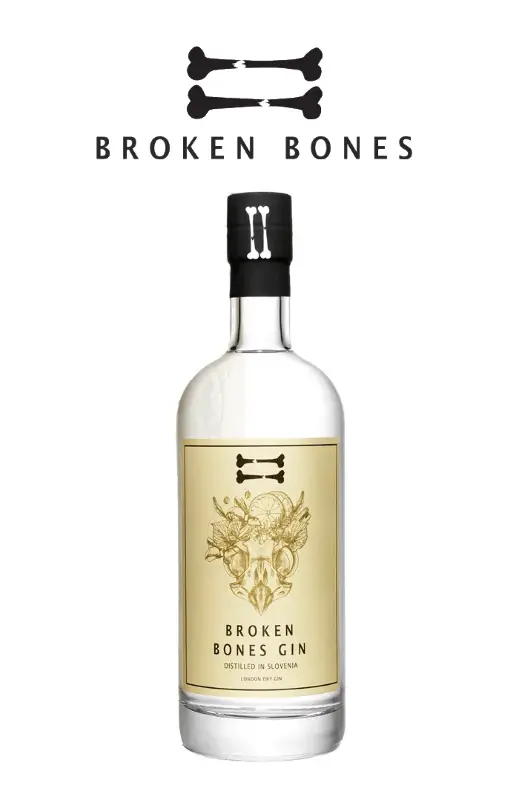
Broken Bones is made in Ljubljana from a distillery that started with whisky before moving on to gin, with the aim of producing a spirit that could be enjoyed neat as well as in a cocktail. The unique flavour of the drink is given by the use of rosehip berries and linden tree flowers, with the latter an especially Slovenian touch, given that this is one of the symbols of the nation. The name comes from when the owners, Borut and Boštjan, both had accidents when working with their first whisky barrels, resulting in a broken leg and broken nose. The gin is made in small batches, with each batch being slightly different. In addition to the standard gin, the company also produces Broken Bones Navy Strength Gin (57% ABV), and is working on Broken Bones Old Tom Gin, with added honey and matured in Slovenian oak casks. Website.
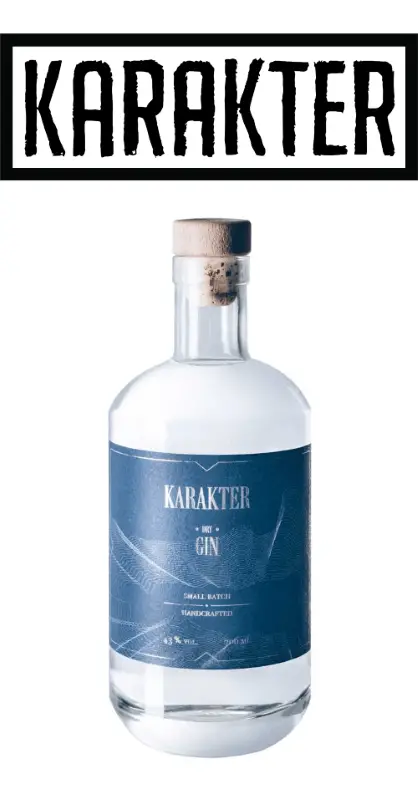
Karakter Gin is distilled by a team who were draw to the spirit for two reasons: first for the relative simplicity of it’s production, and second because gin is a drink that allows for a wide range of experimentation. The result is thus a gin that has character, hence the name, and one that seeks to explore the basic idea of gin by brining out the complexity of the usual juniper berries and botanicals by adding various atypital herbs and spices. If that sounds intriguing then seek out a bottle or glass of Karakter Dry Gin, produced using maceration, infusion, and percolation. Website.
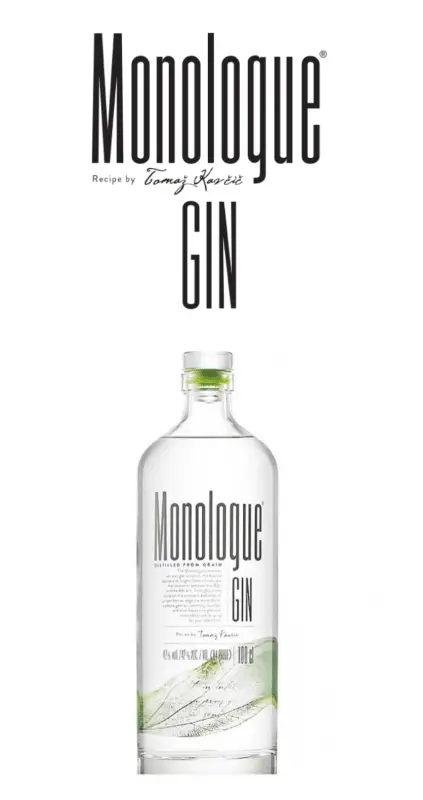
Monologue Gin is the first “celebrity” gin in this series, presented by Tomaž Kavčič, the top chef of the famed Pri Lojzetu. The twist on this gin is that Kavčič has aimed to capture the taste of Vipava in the spirit, which in addioion to the usual herbs and botanicals is flavoured with rosemary, lavender and an extract of olive leaves. No website at present, but the restaurant can be found here.
Other articles in this series can be found here
STA, 21 May 2019 - The company Hurra Studios' Little Heroes start-up project, creating personalised children's books, was declared the Slovenian start-up of the year at a ceremony during the Podim start-up conference in Maribor on Tuesday.
Little Heroes's customers can choose the name, gender and appearance of their protagonists as well as the content of stories.
In addition to personalised books, Hurra Studios also sells other products, including gift boxes, which account for over 25% of the company's business, which has led to a significant change in Hurra Studios' revenue sources, said the conference organisers.
The company has so far attracted more than 600,000 customers, with the number expected to rise to 1.5 million by the end of this year.
Its trade is also rapidly increasing and expanding to other countries. Besides Slovenia, the company is present in Italy, Austria, France, Germany and the US, while also planning to enter the British, Canadian and Australian markets.
The Ljubljana-based company employs more than 100 people in the capital and over 250 at the global level.
The award was handed out for the 12th time by a judging panel which featured entrepreneurs, mentors, investors and other members of the Slovenian start-up world.
The Podim conference is considered one of the leading start-up events in the Alpe Adria region and the Western Balkans. Last year, the award went to Next, a start-up that developed an online cleaning service platform called Beeping.
You can learn more about Hurra Heroes – also called Hooray Heroes – here
Slovenia is a small country, with just over two million people and a capital where it can be hard to find something to eat after midnight. But that doesn’t mean it isn’t home to businesses, artists and designers who can enjoy its sleepy charms while still engaging with the wider world. One of these is Olga Košica, a jeweller, artisan and artist who can be found working in the small studio she shares with Martina Obid Mlakar in Ljubljana's Old Town, designing, making and selling her pieces around Europe, in Asia, and elsewhere. Intrigued by her story, I got on my bicycle to learn more about how a small business, drawn from the hands and heart, could do all this. Along with some pictures of Olga’s work, here are some excerpts from our conversation
I started my career almost by chance. I took a short course in college, an introduction to jewellery, and was fascinated. From then on I wanted to learn more. I couldn’t do that in Slovenia, because there weren’t the schools, so I applied to study in London, at the Royal College of Art, and was lucky enough to be accepted, and I did my MA there.
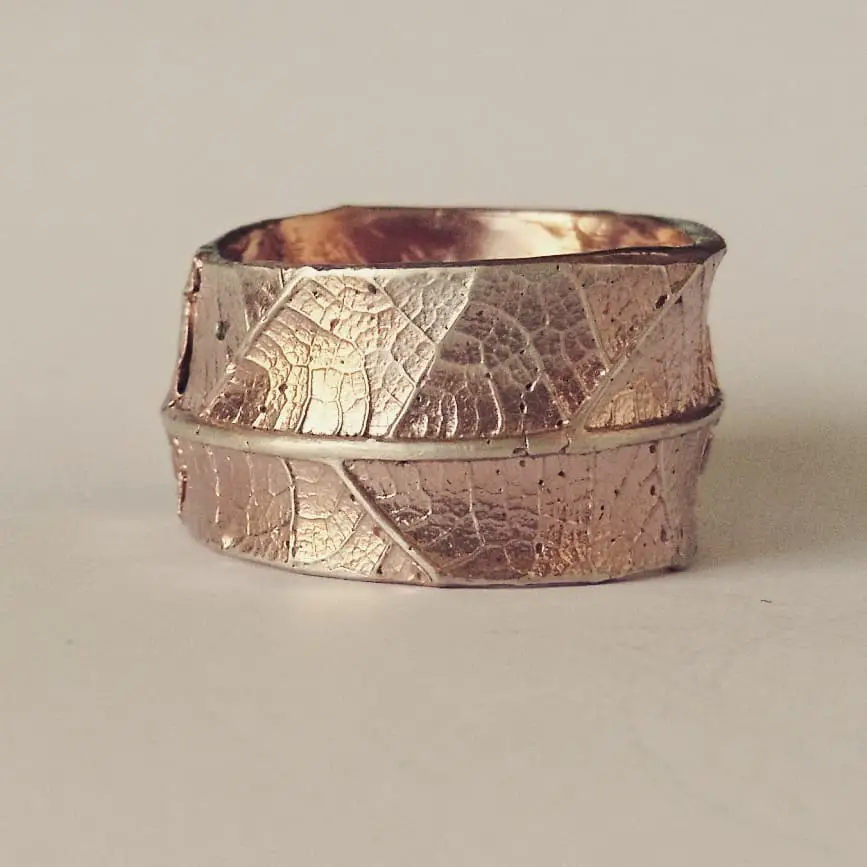
Photo: Olga Košica
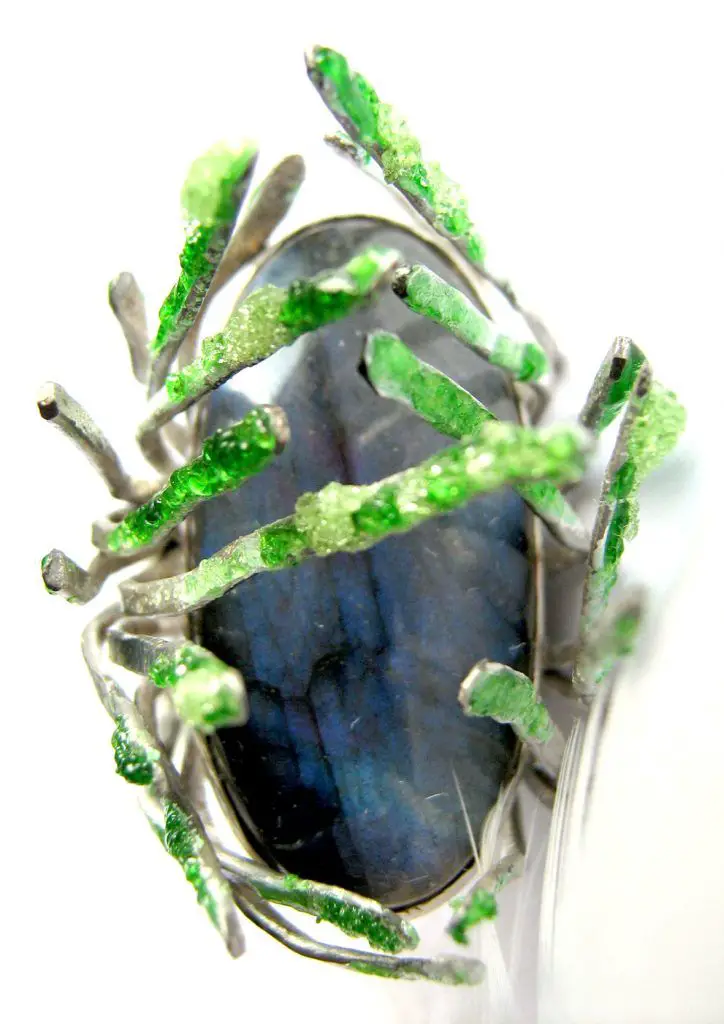
Photo: Olga Košica
I already had some basic knowledge, but at RCA they really encouraged me, and saw my potential. They also provided a lot of support, in terms of, say, technicians and equipment. I was there for two years, working every day, but it was wonderful, because there’s everything at your disposal. It’s a great school.
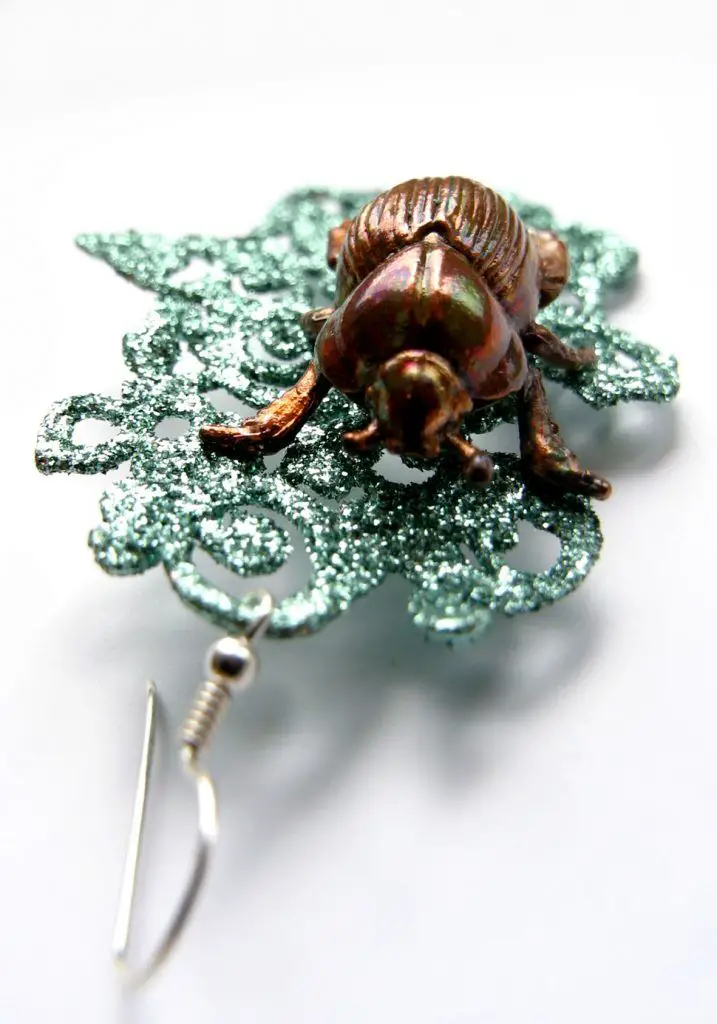
Photo: Mimi Antolović
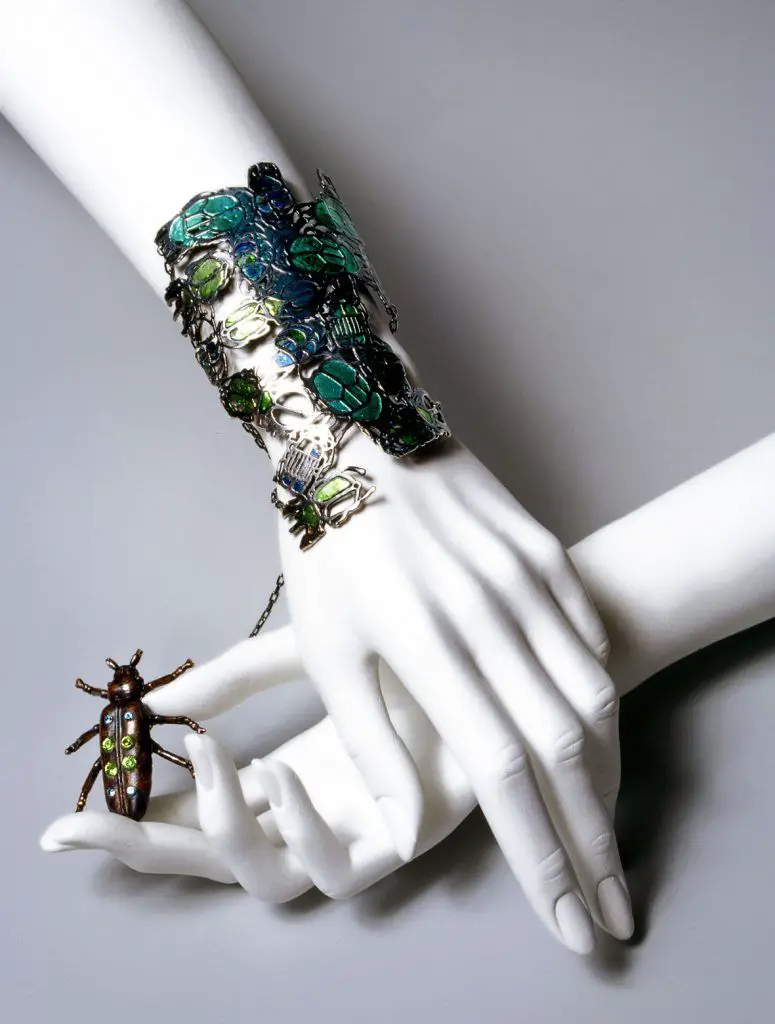
Photo: Mimi Antolović
Back then I was rying many different things, and you can still see some of those pieces here in the store. A lot of them, like this necklace, were electroformed using wax, but – as you can see – this piece is falling apart, because I’ve loaned it out for so many fashion shows, photos shoots, and so on. I did a lot of electroformed pieces in London, which looked like coral, and also beetles, a lot of beetles, because when I start something it’s like a production line.
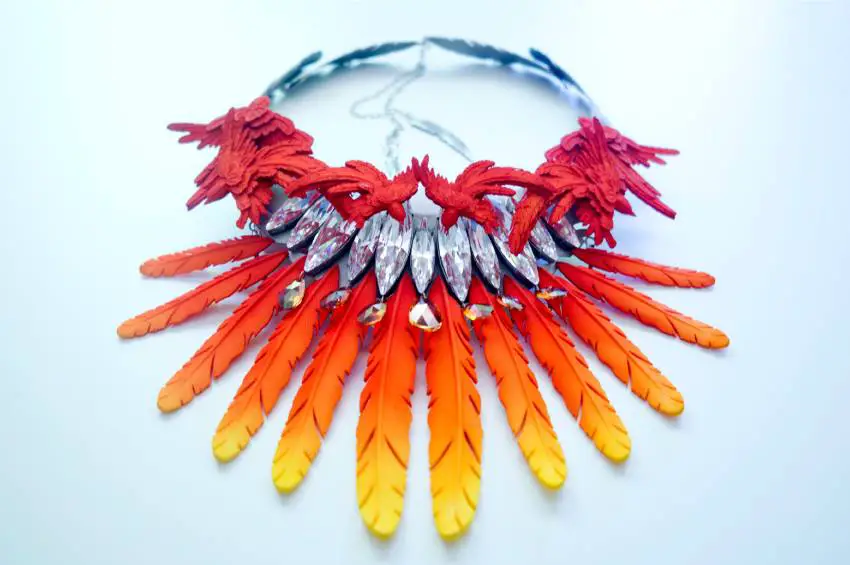
Photo: Rok Marinšek
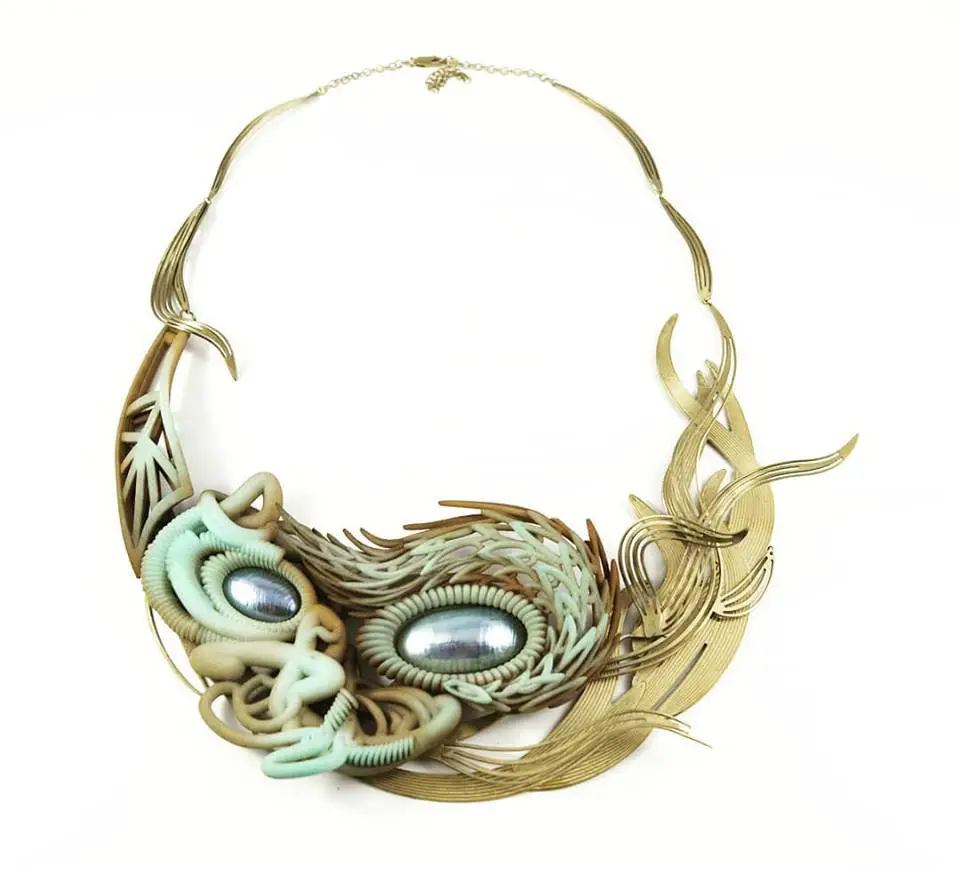
Photo: Rok Marinšek
I work freelance. This is my workshop, so here I can handmake certain pieces. But when I work for Zlatarna Celje I just make the designs, not the physical pieces. I've been working with them for 14 years now. I did some gold collections, but mainly I worked on their silver line – LENCIA.
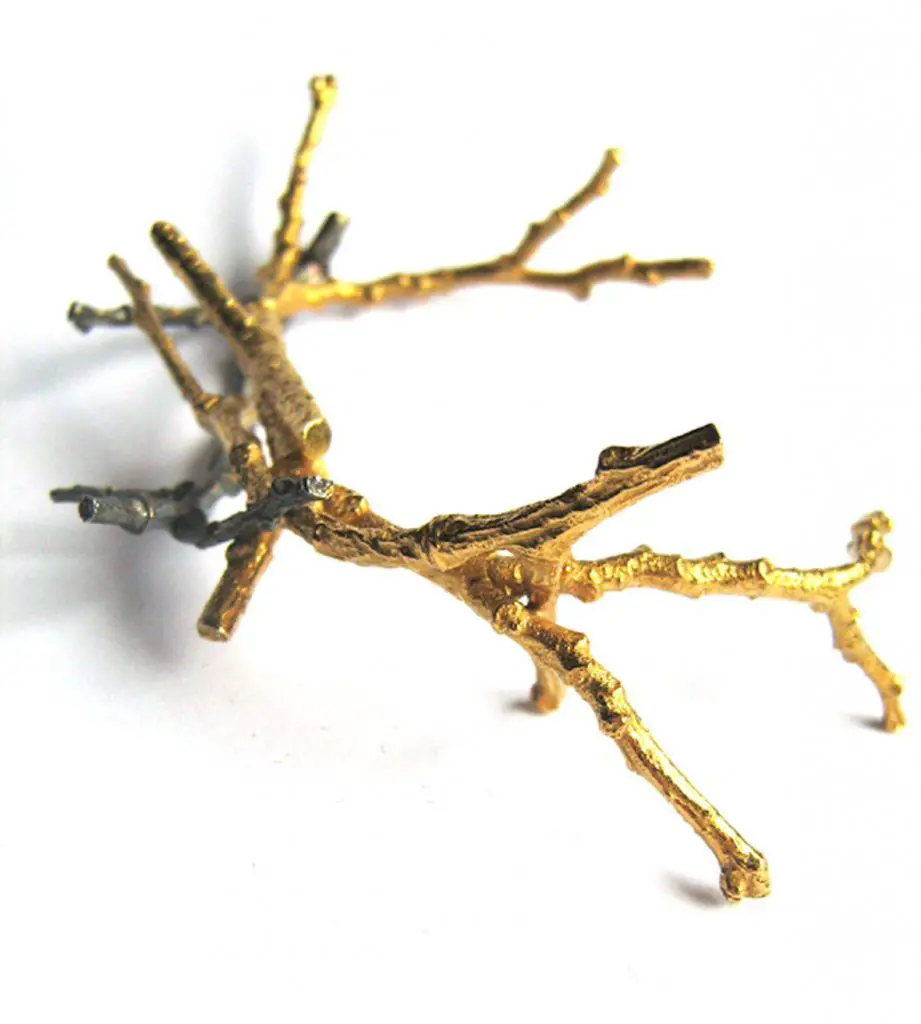
Photo: Olga Košica
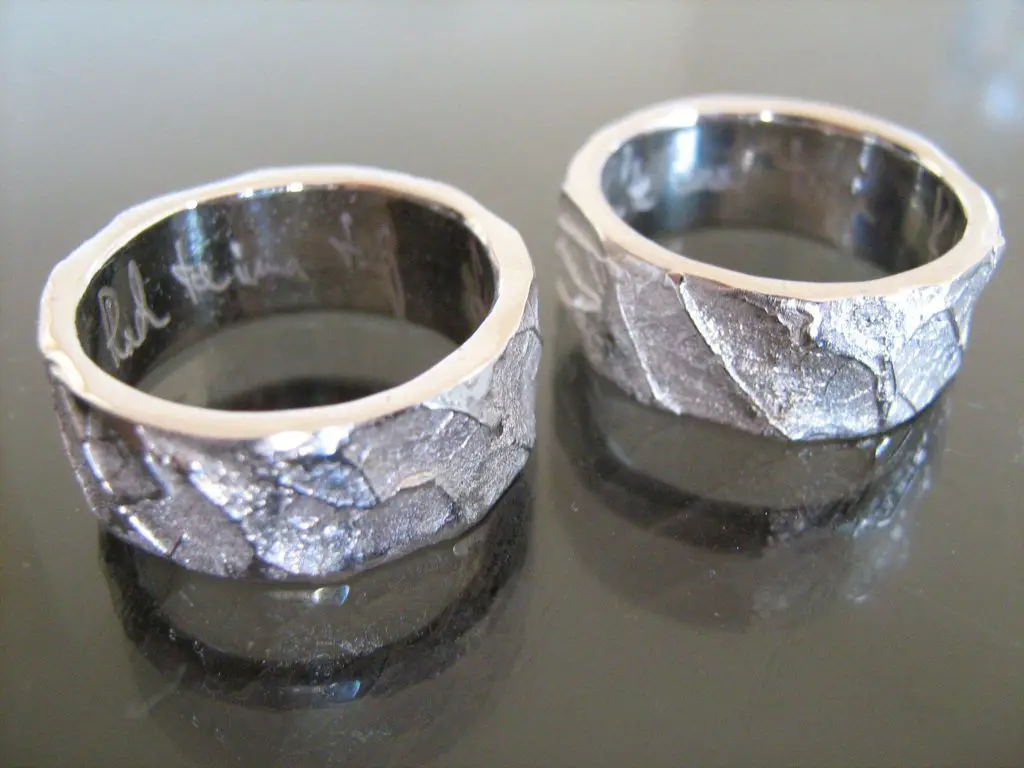
Photo: Olga Košica
Another project I spend a lot of time on is 3-D printing, which I do along with the graphic designer Rok Marinšek for the Chinese designer Masha Ma, to be used as part of fashion show at Paris fashion week.. They’re made of polyamide, and they’re really fun. We started about 6 years ago, when in Maribor they’d just got a huge machine. It was very exact, the best for its time, and they wanted some designers to use it, to see what could be done.
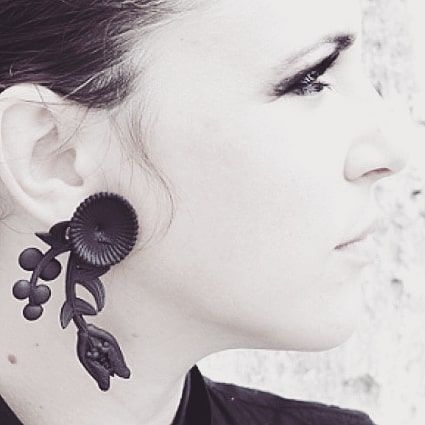
Photo: Rok Marinšek
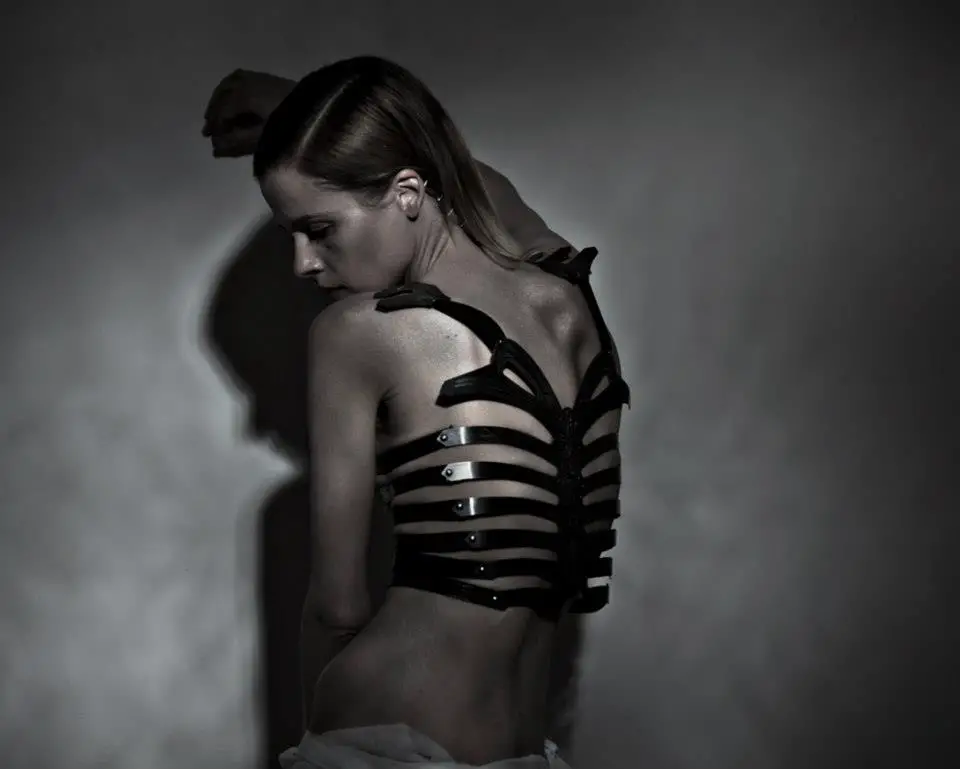
Photo: Matjaž Banič
We played around with it and produced some really interesting things. Some of those were taken to Paris by Andrej Skok, a Slovenian stylist who works with Masha Ma, and that’s how that collaboration started. We produce some of this here in Slovenia, but for certain pieces we send the files to i.materialise, a Belgian company.
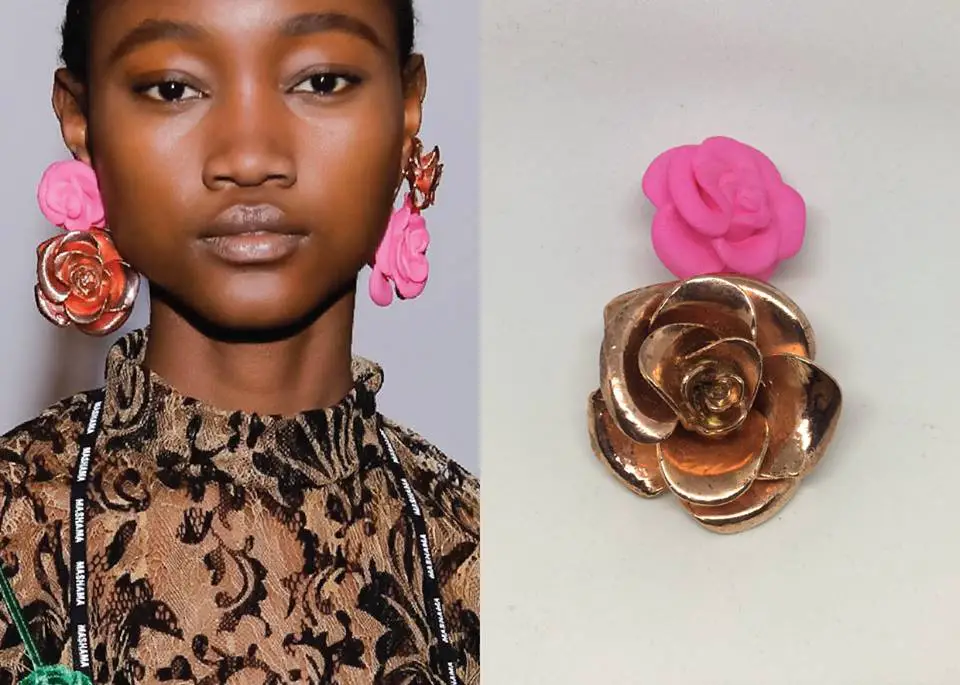
Photo: Rok Marinšek
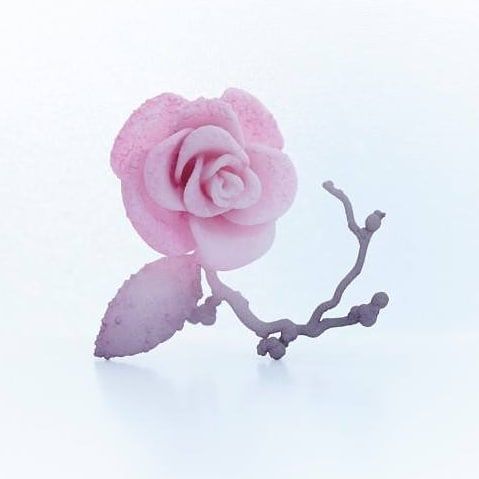
Photo: Rok Marinšek
I move between different projects and different ways of working. So sometimes I’m working on the computer, producing a file for 3-D printing, and with that you can go into incredible detail that wouldn’t be possible by hand. For example, I made some 3-D printed frozen flowers, and you can see the ice. But these aren’t real frozen flowers that were scanned, they were all designed. And then when you have the data of course you can change the size, stretch it, copy-paste it, move it around. In that way you can get a lot of different pieces out of one design element.
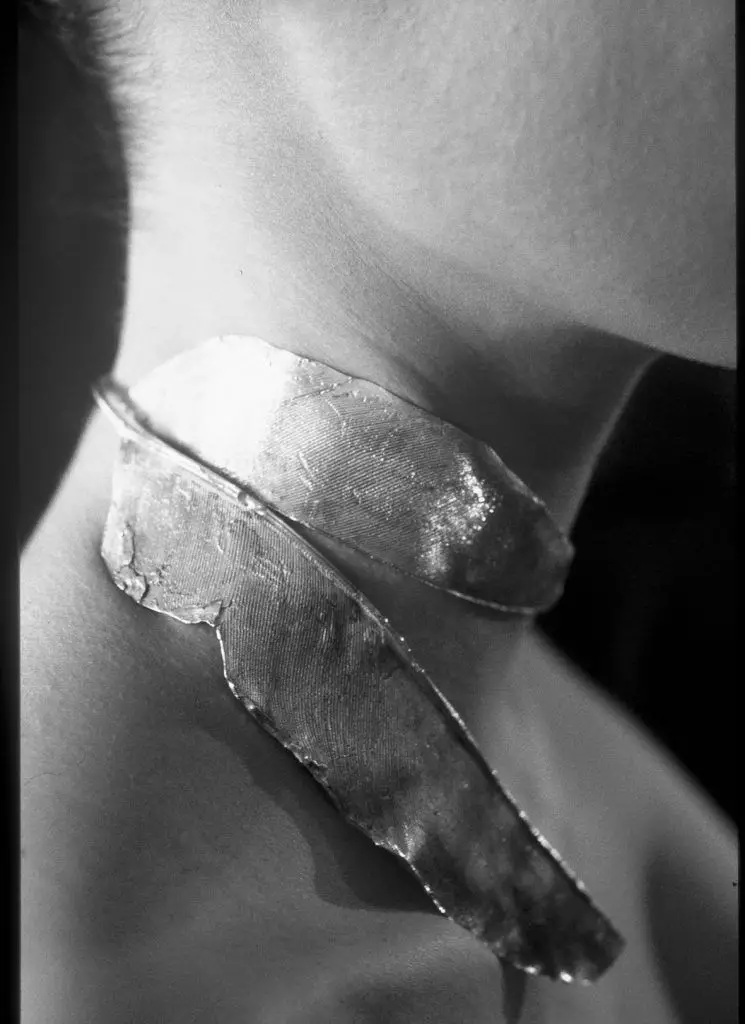
Photo: Mimi Antolović
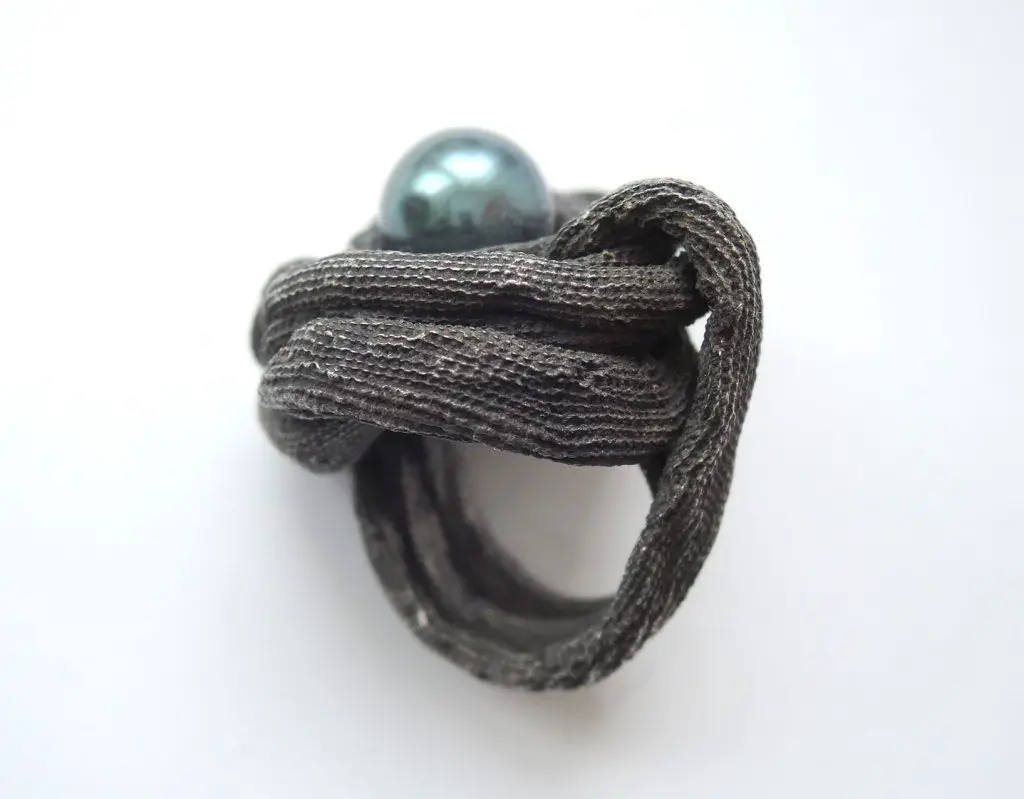
Photo: Olga Košica
But then I also enjoy making the pieces myself, in the workshop, because that can be more spontaneous. Of course, people are surprised when they come to the workshop and they see the reality. Jewellery is very delicate, but the process of making it can be very brutal, and you need a lot of force to stretch metal, change its shape, or make some wire. Which is why this all used to be seen as men’s work.
You can see more of Olga Košica’s work on her website or, if you happen to be at the far end of Ljubljana’s Old Town, visit her workshop instead at Gornji trg 26.
We’re huge fans of the K67 kiosk, the modular unit that (as noted in our earlier feature):
was designed in 1966 by the then young Slovenian architect Saša Janez Mächtig (b. 1941, Ljubljana), a former student of Edvard Ravnikar, and put into mass production in various colours two years later. It was made of reinforced polyfibre, steel, and glass, and was intended as to be used as part of modular structures – as seen in some of these photographs – as well as for temporary events. While they stopped being produced shortly after Slovenian independence, many still remain in use around Eastern Europe, although more have disappeared, and others sit abandoned, waiting to be rediscovered by urban explorers.
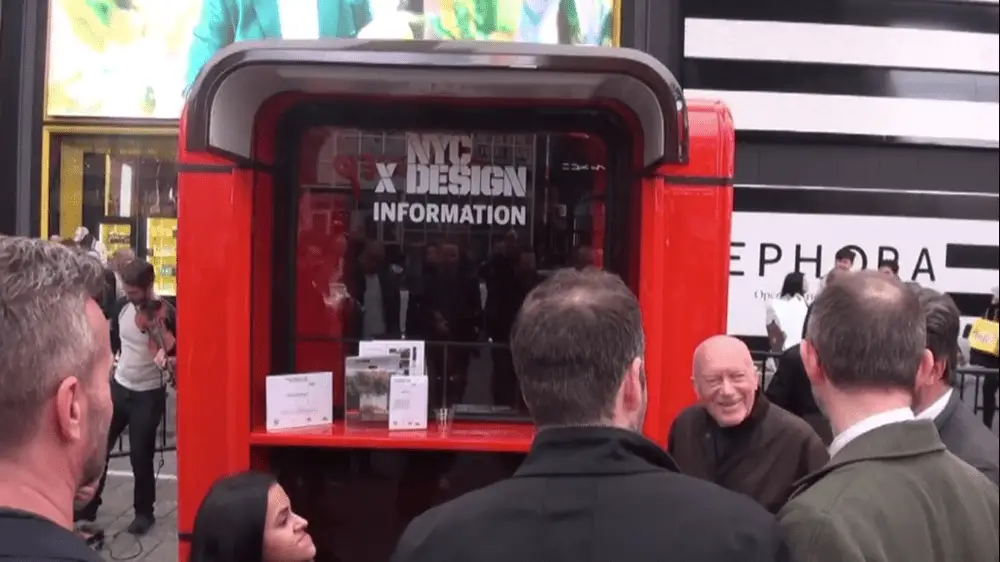
Saša Janez Mächtig, the designer, in front of one of his many creations. Screenshot from the www.24ur.com report
While one of these little wonders sits in New York’s MoMA, another has is now touched down not far away in Times Square, as part of the NYC Design Pavillion, fulfilling one of its more traditional roles as an information centre. The event runs until May 22, and you can see a short video report on the K67, including an interview with the still vibrant Saša Janez Mächtig, here. The president of the Times Square Alliance, Tim Tompkins, can also be seen saying that the aim of the event was to present the best design from around the world, and joked that the K67 brought a little bit of Europe into the New World, a bit of beauty to a not-so-beautiful place, even a bit of socialism to the centre of capitalism.
K67s in the wild, courtesy of Google Image Search
You can learn more about the K67 in our earlier story, and add a little excitement to your time in Slovenia, and nearby, by then being to spot a design classic that really does deserve the title hidden gem.
All our stories on architecture in Slovenia can be found here


